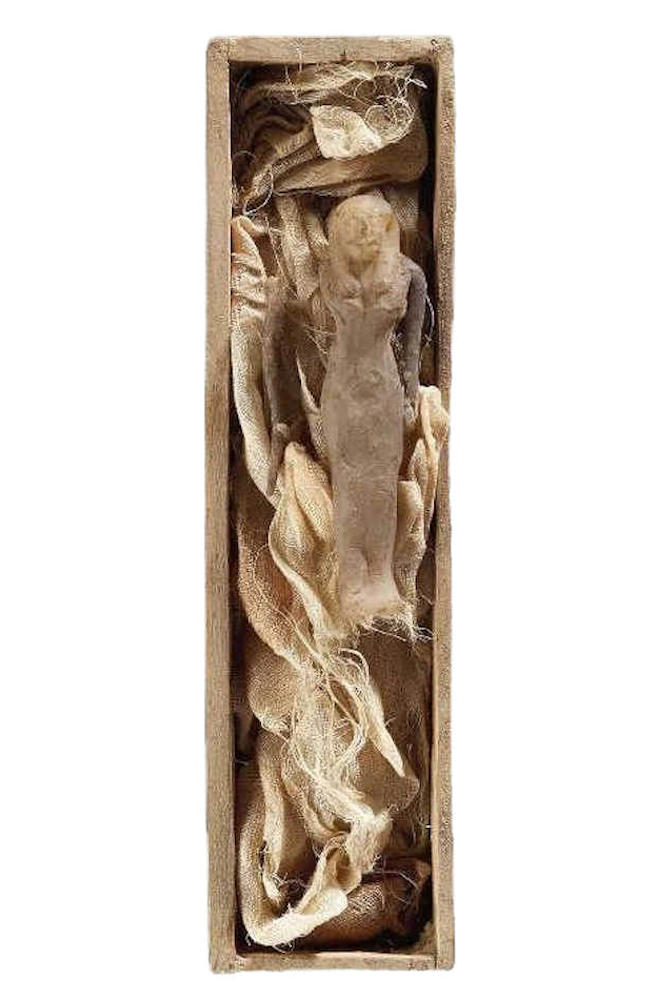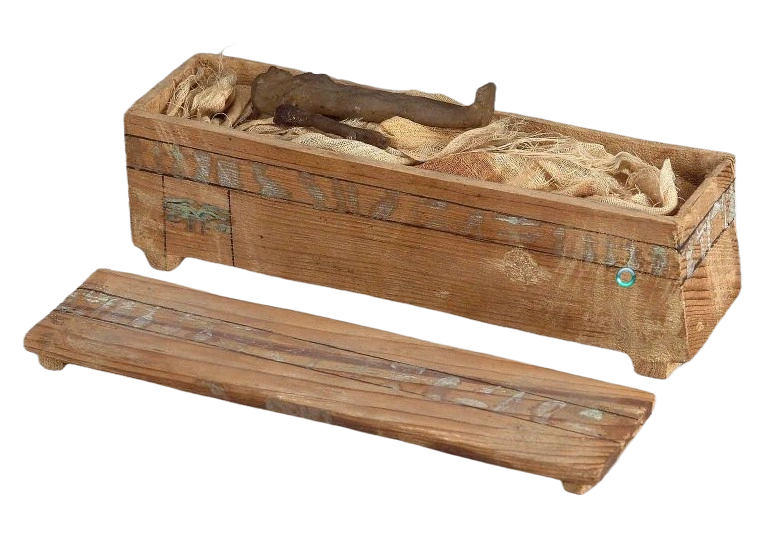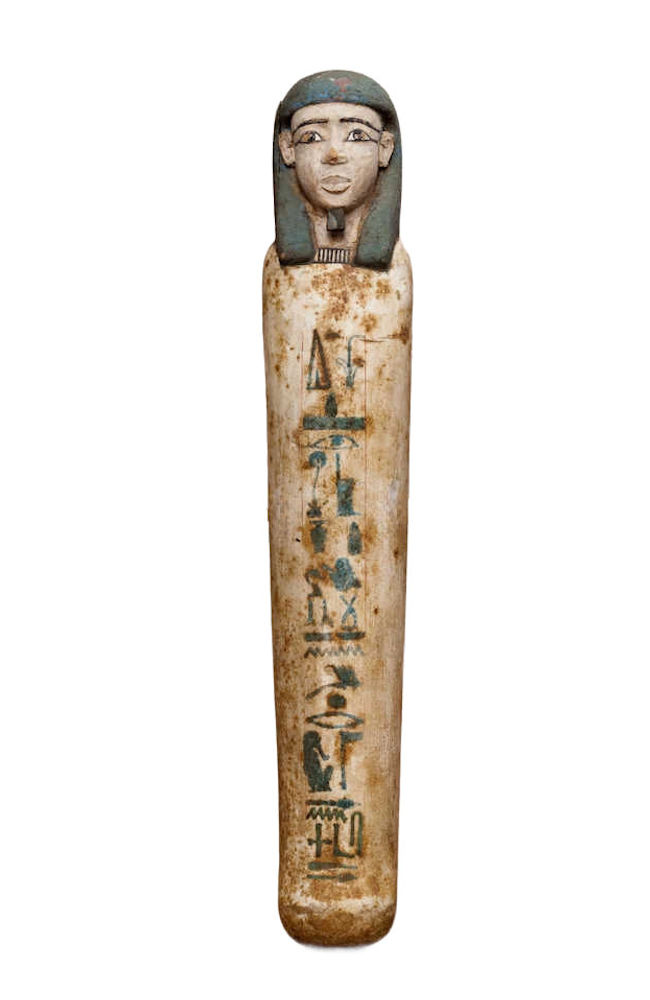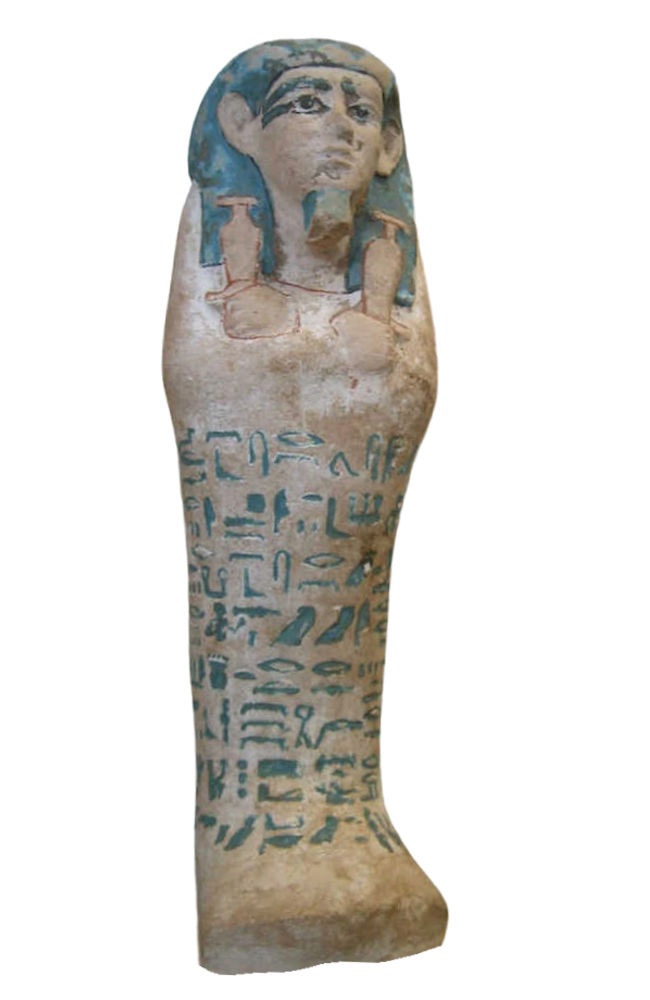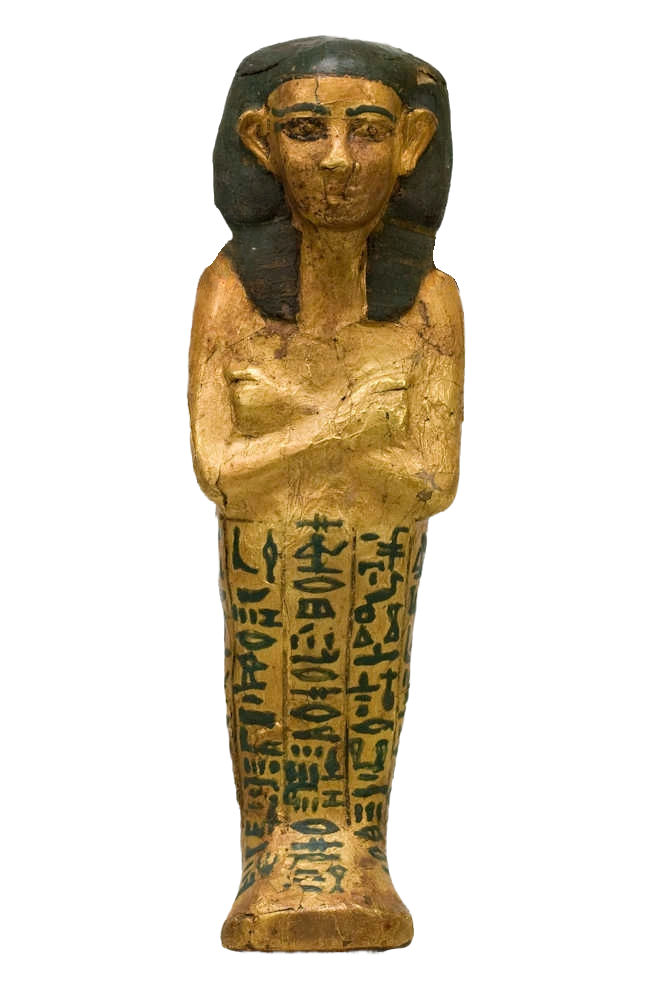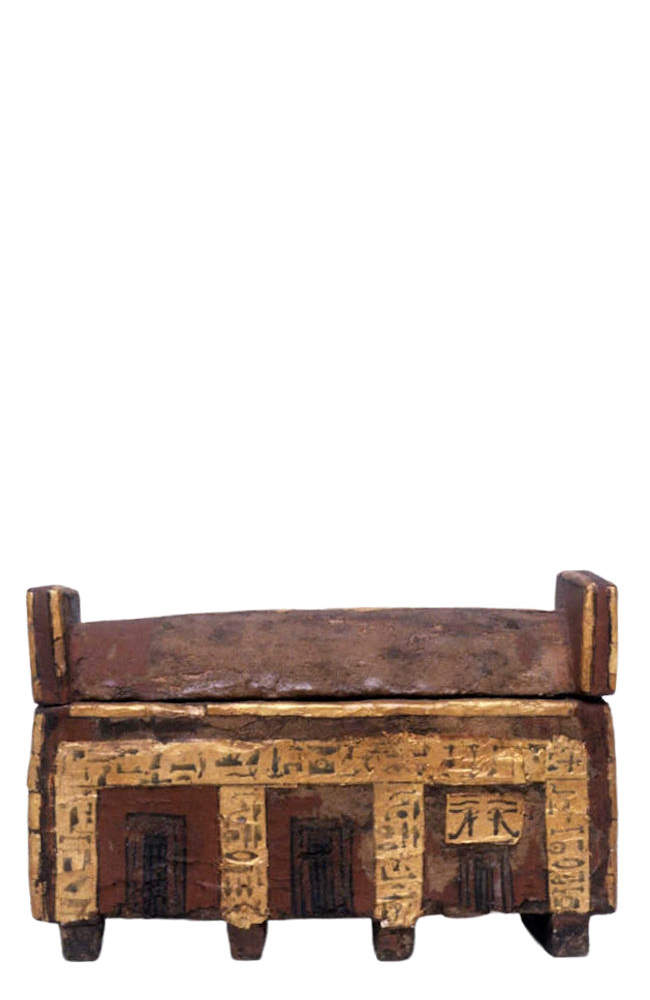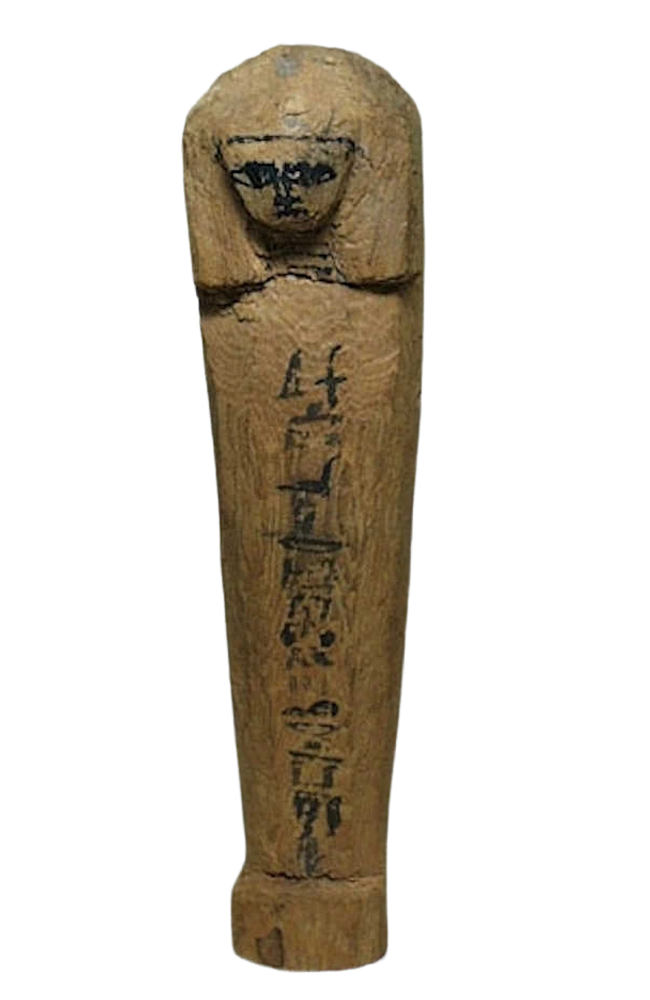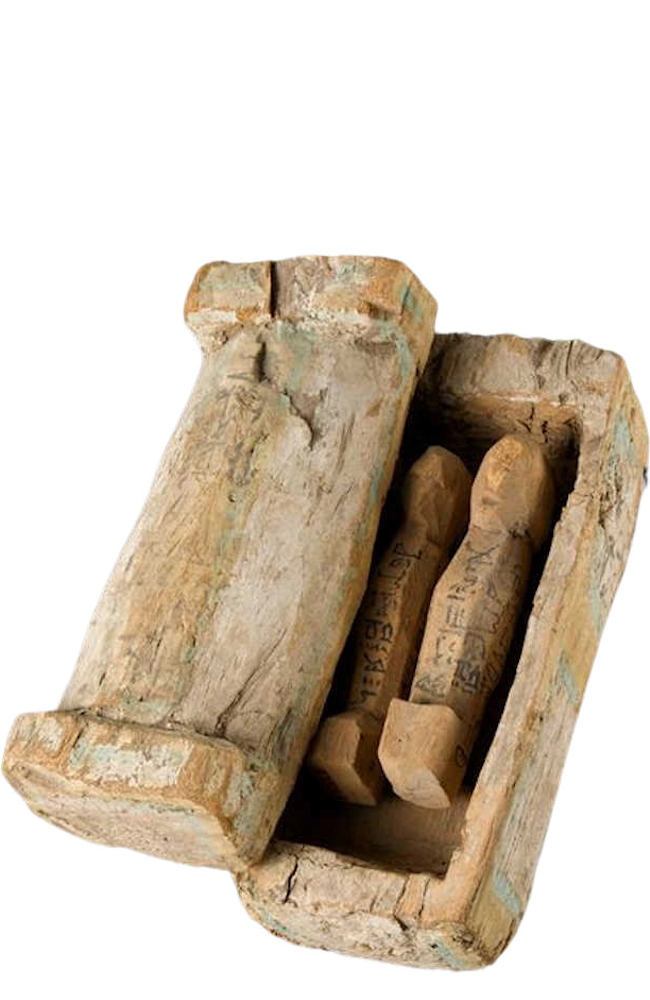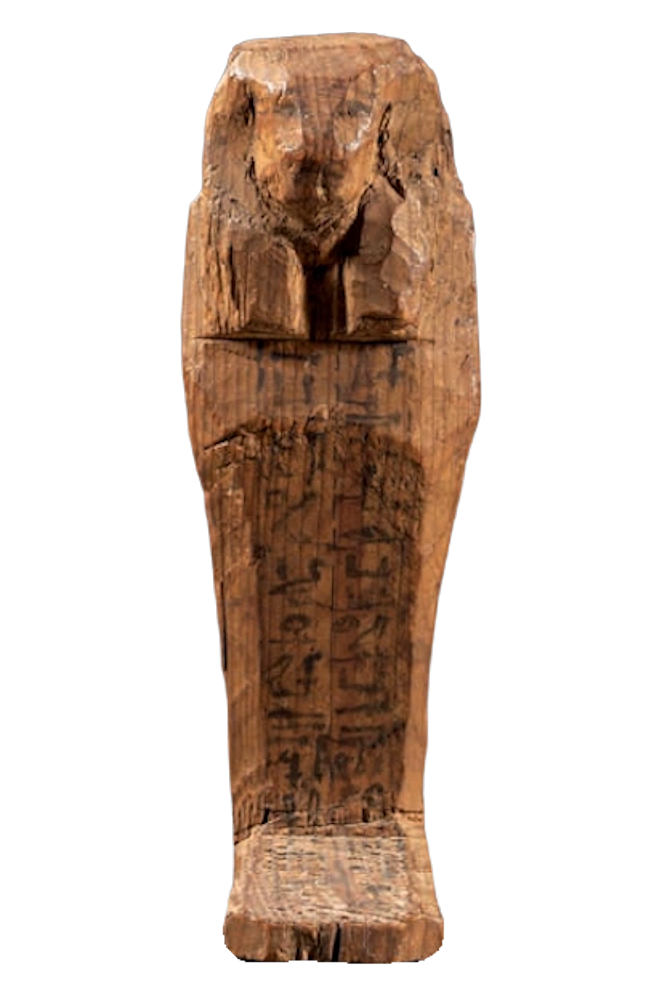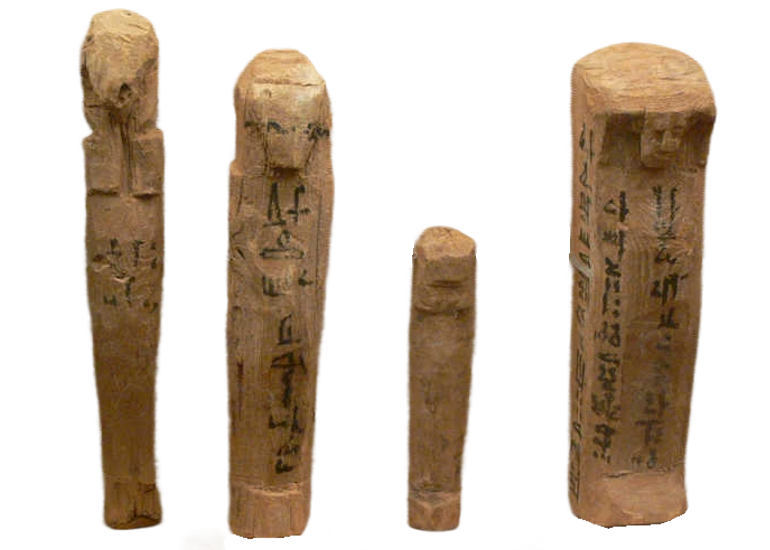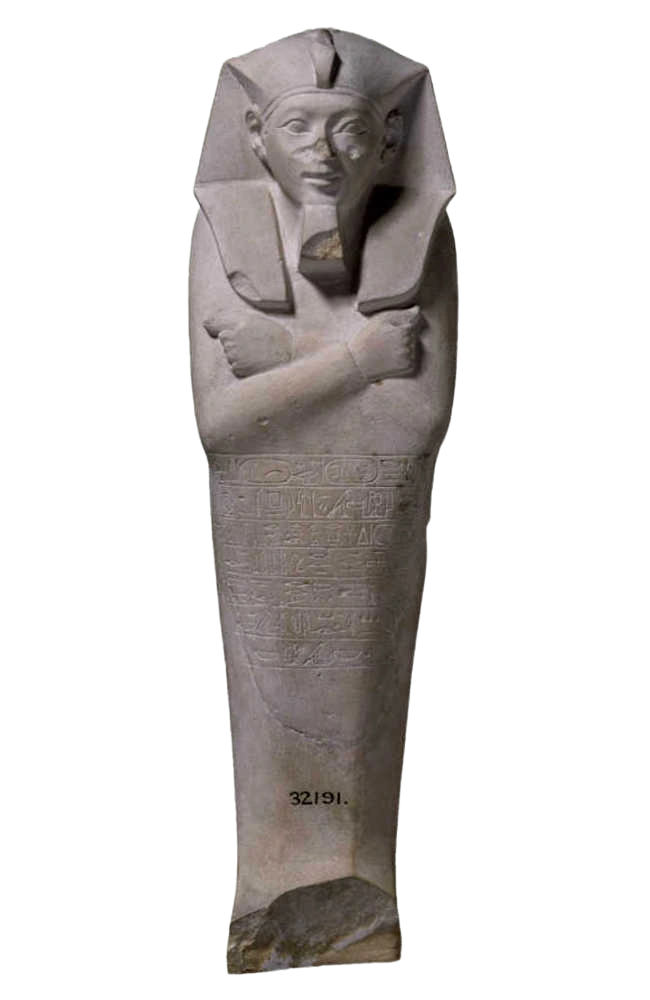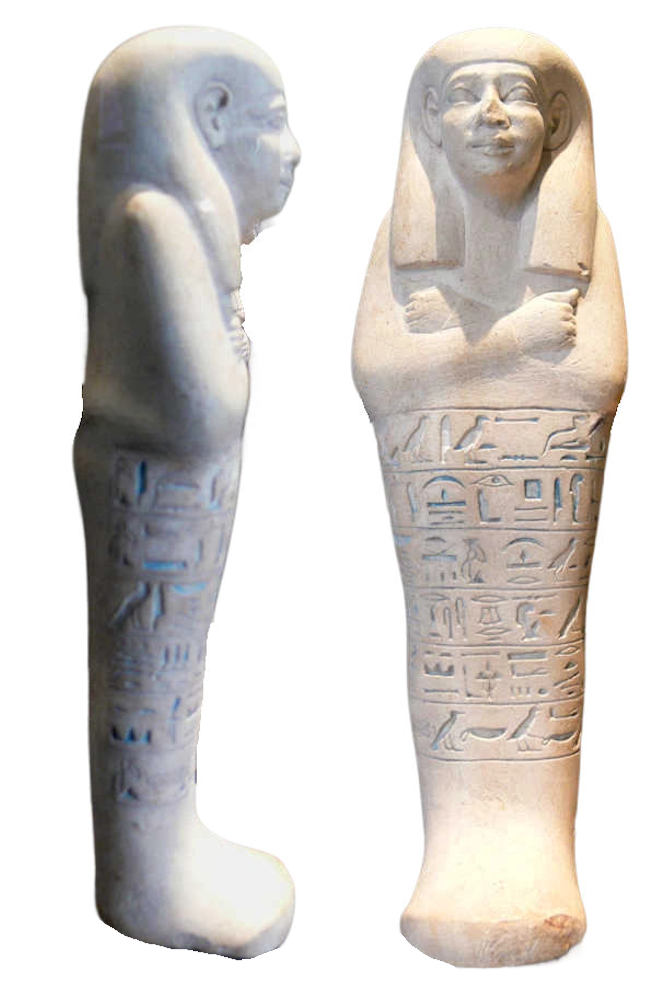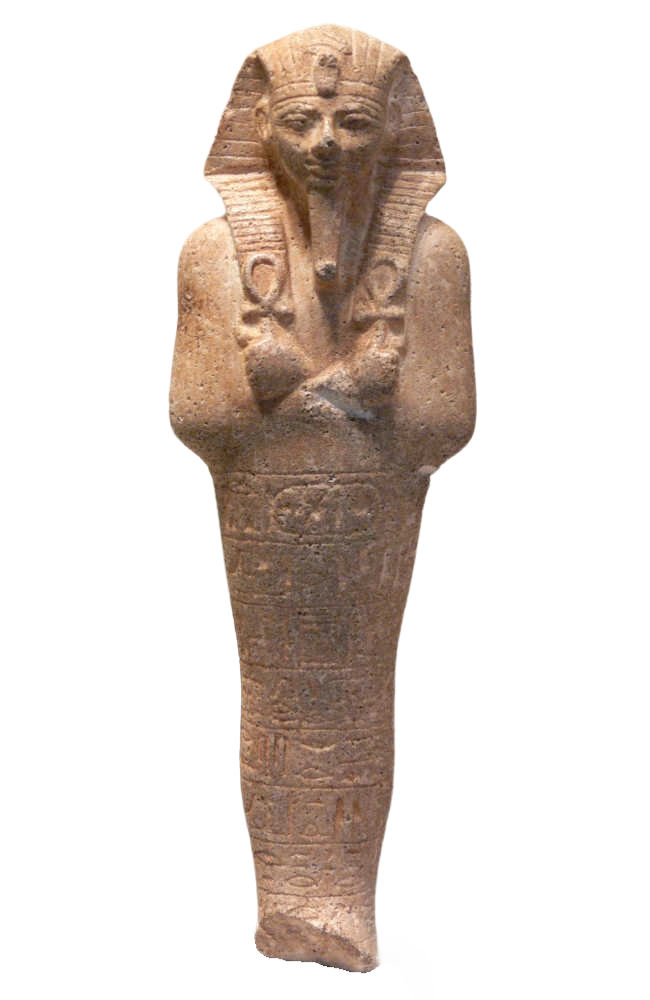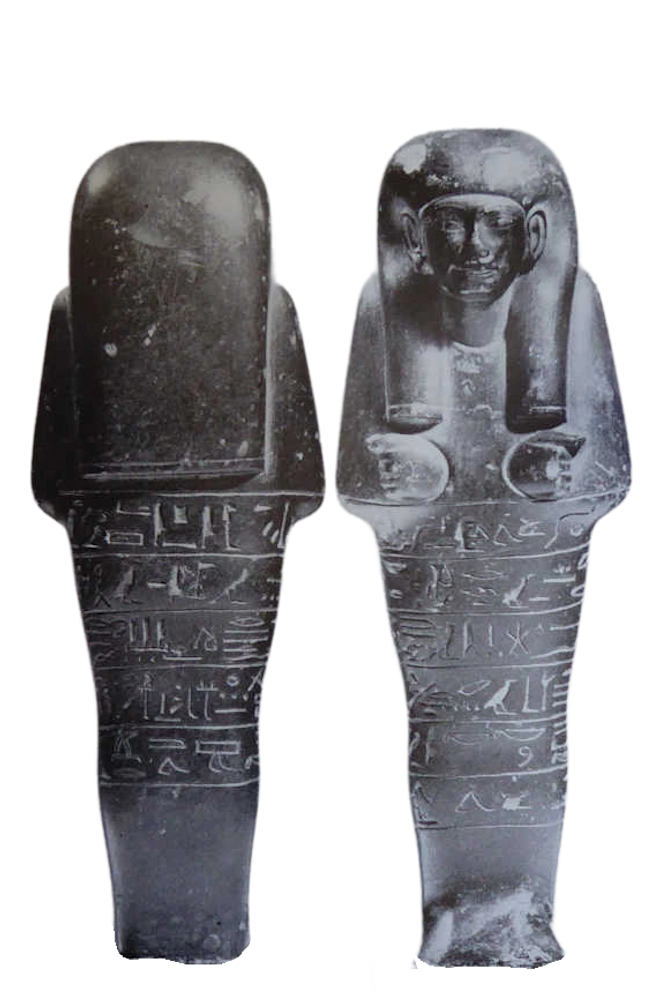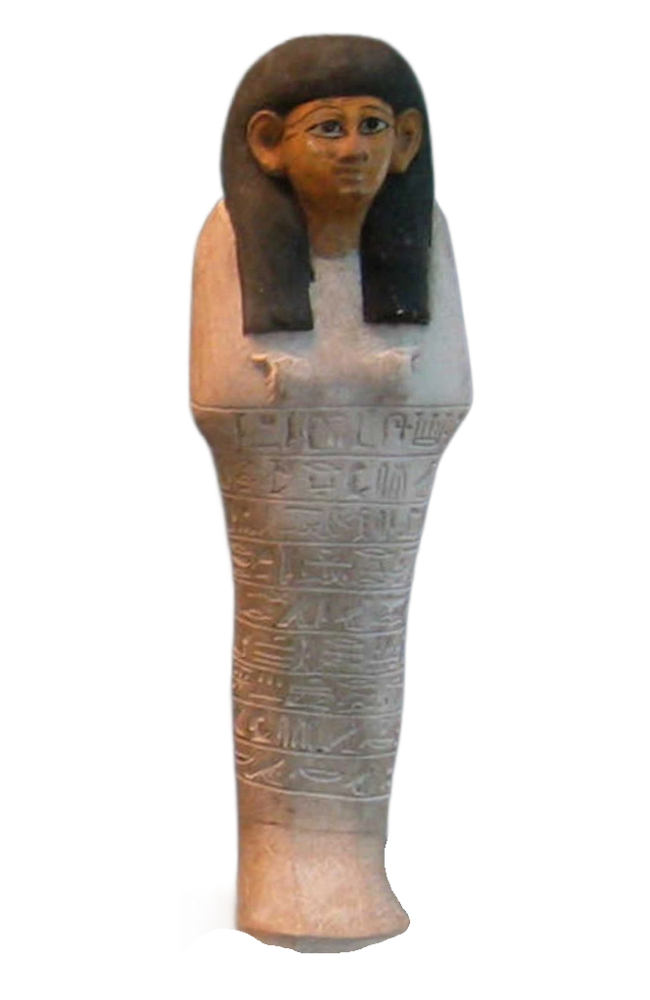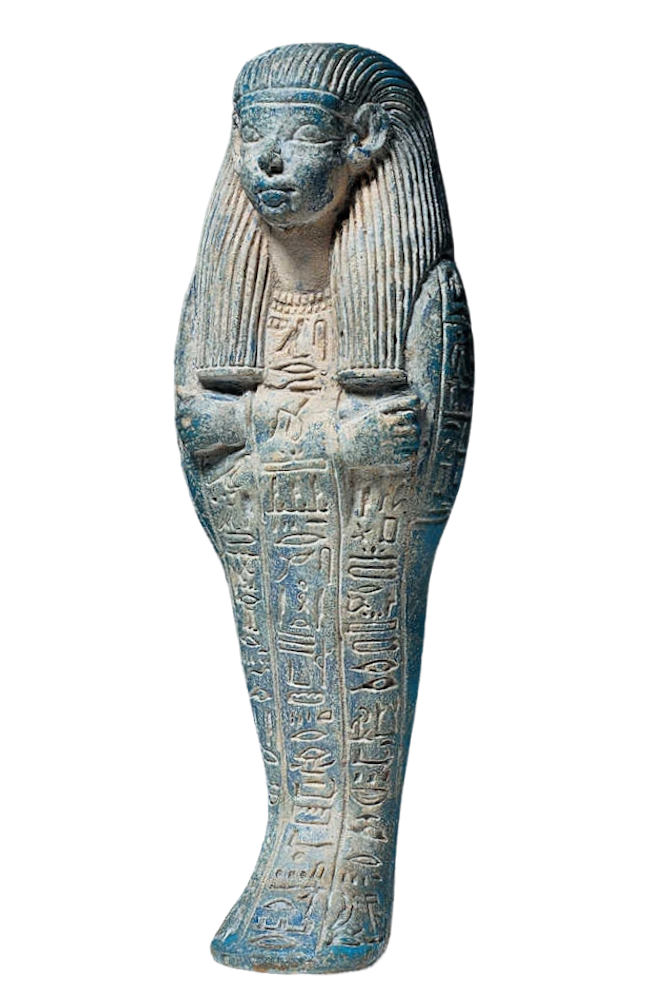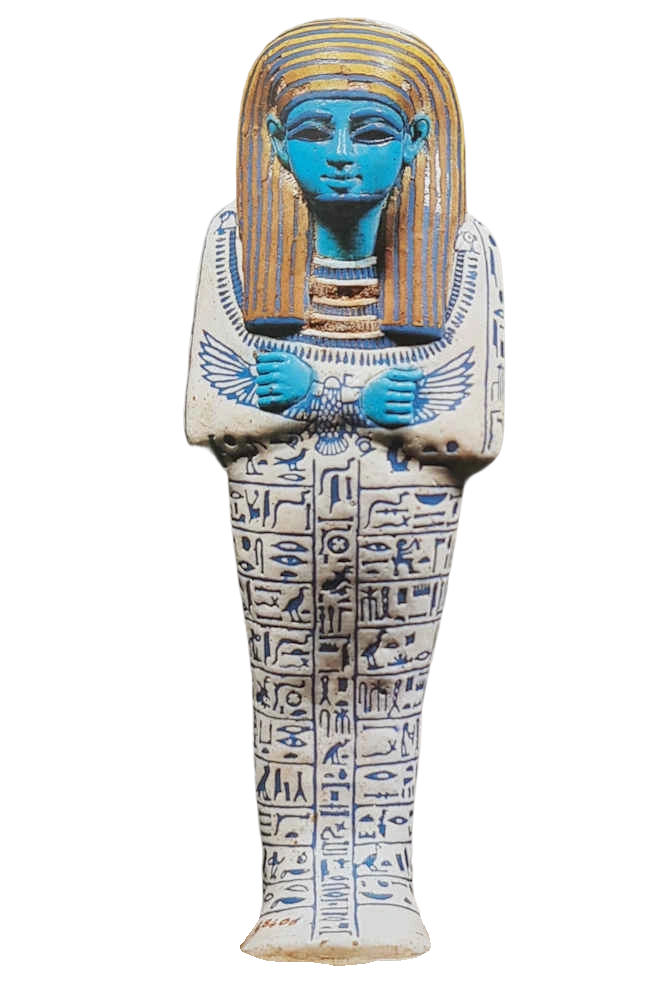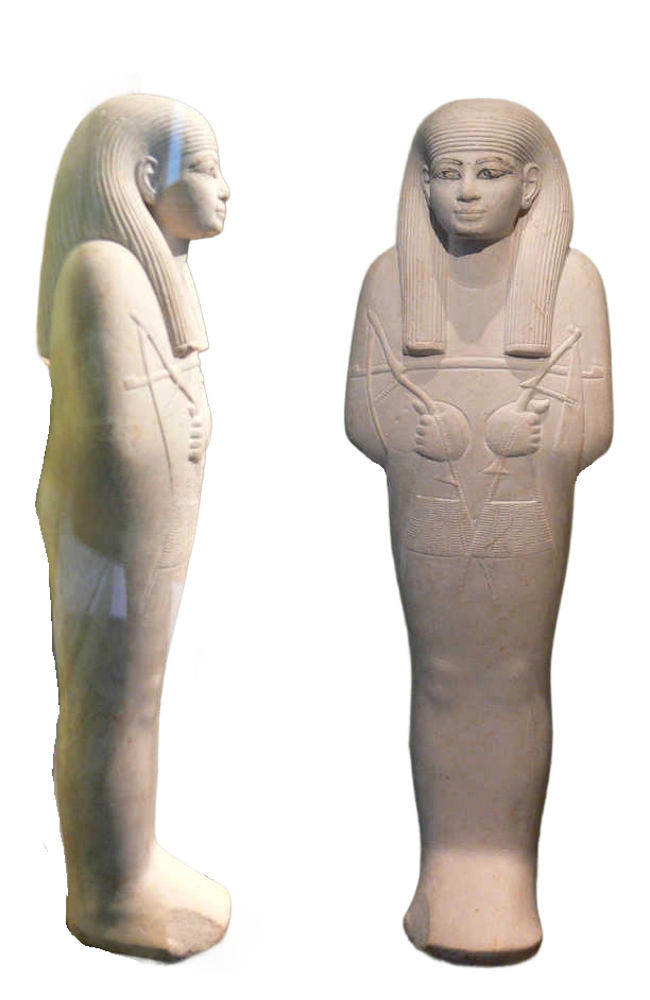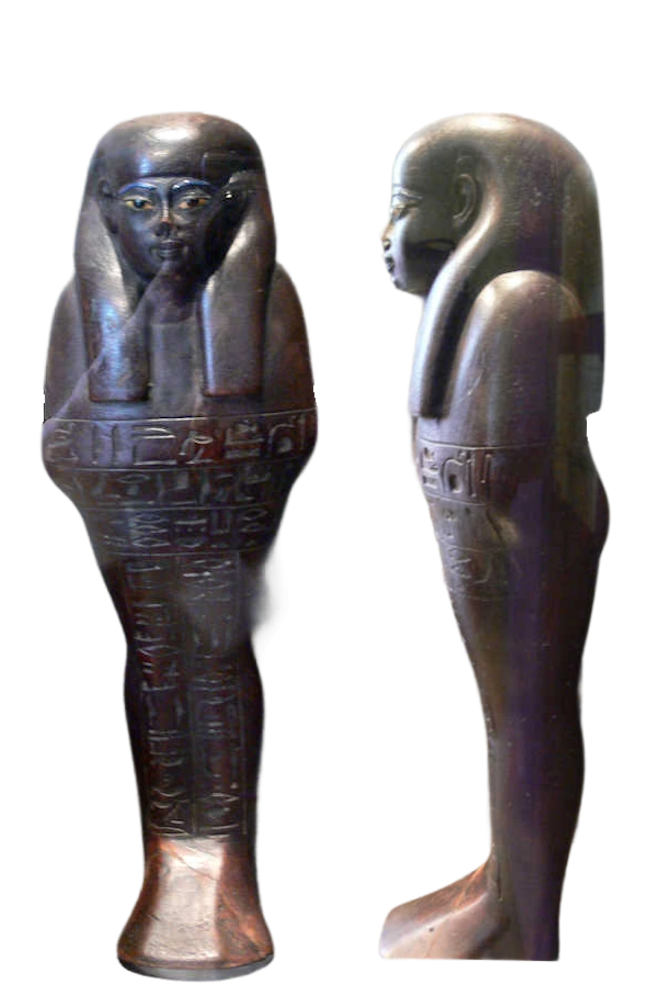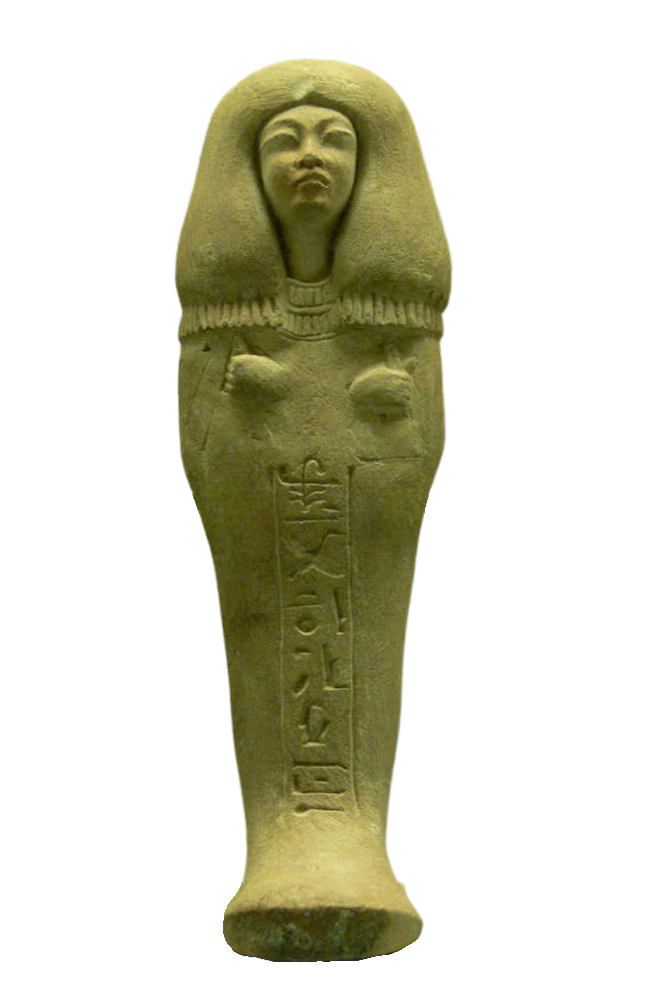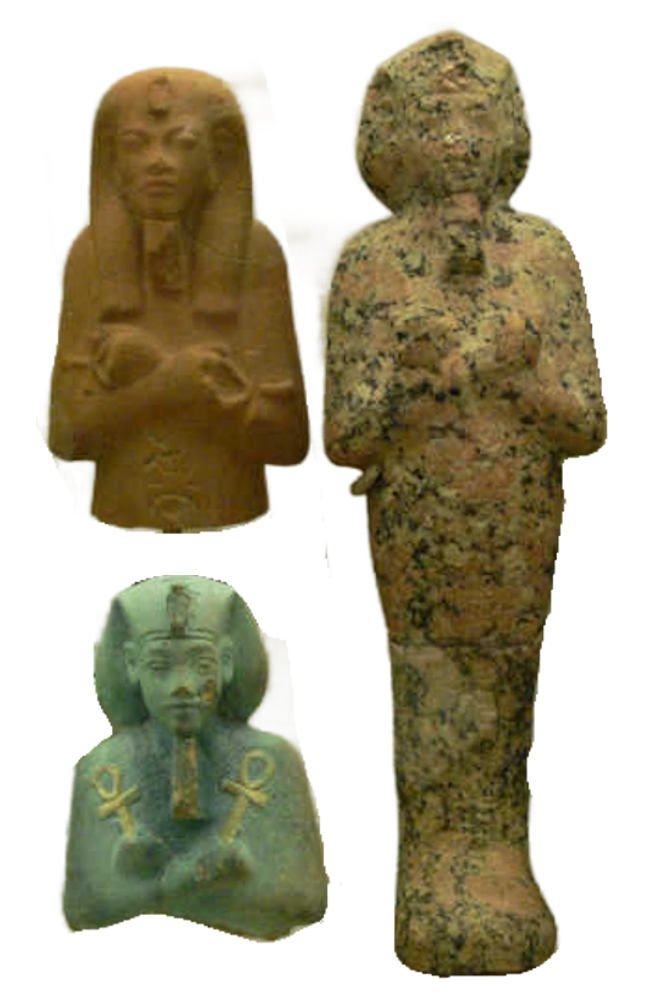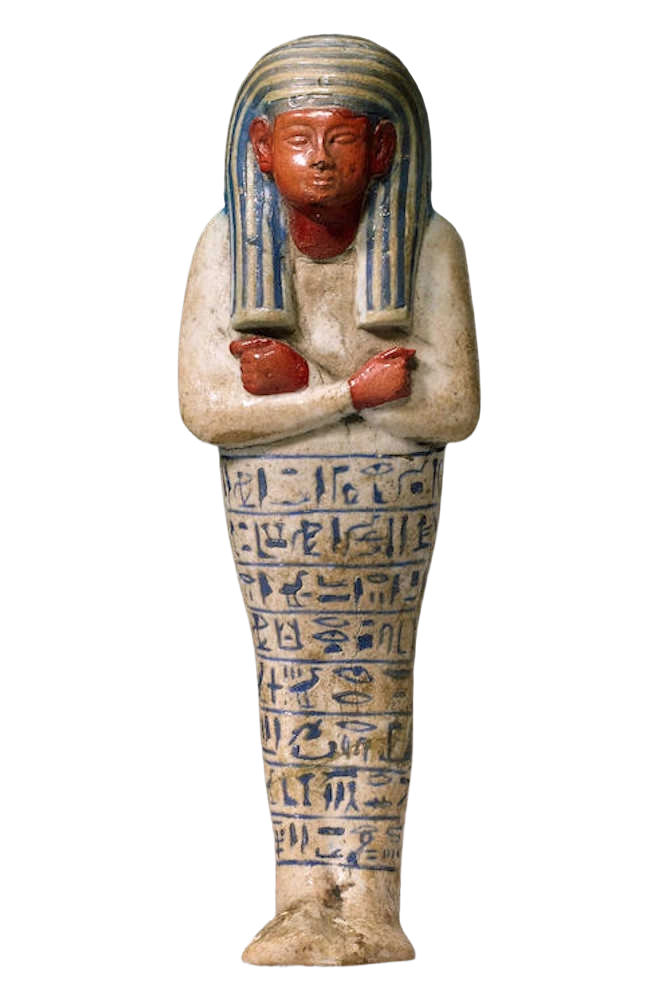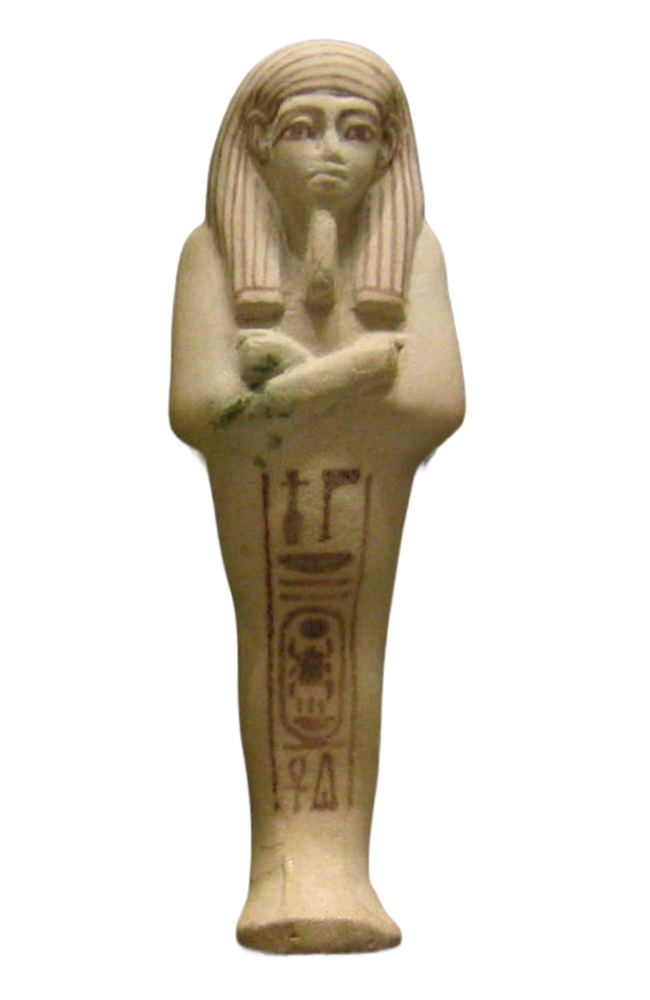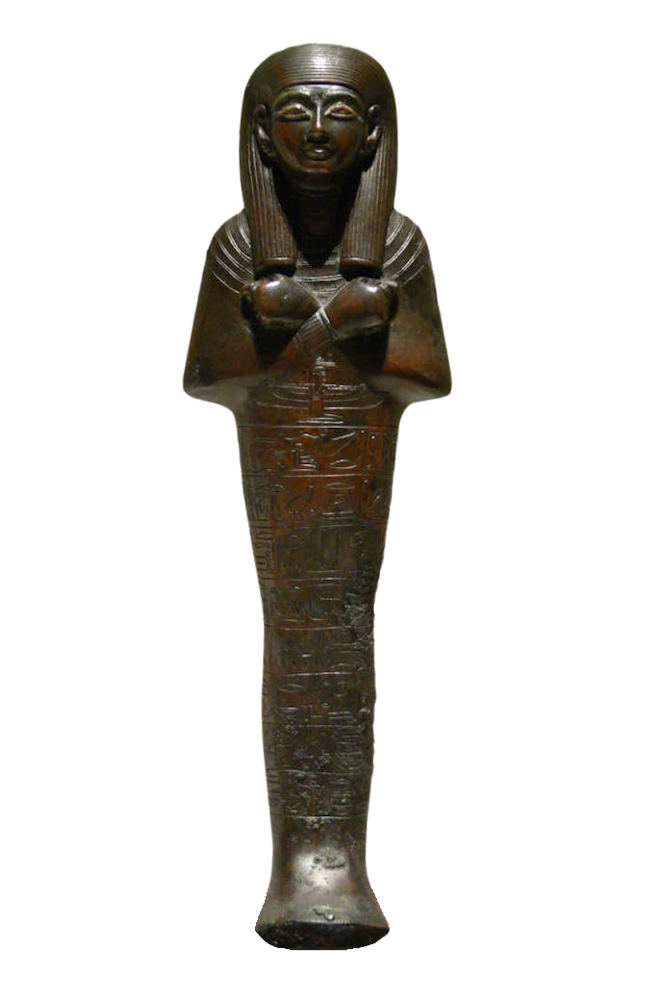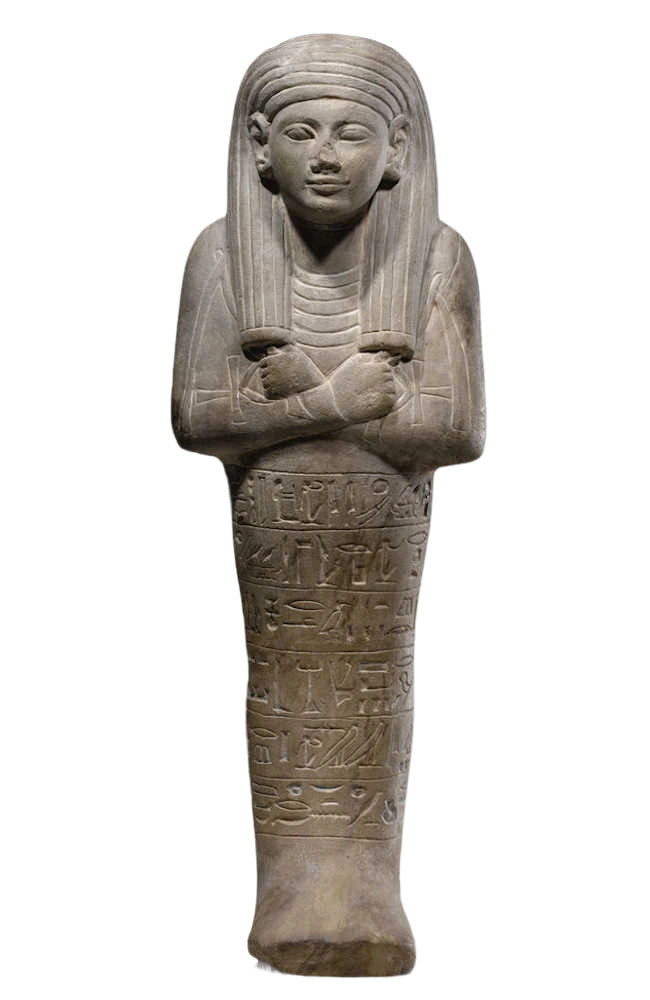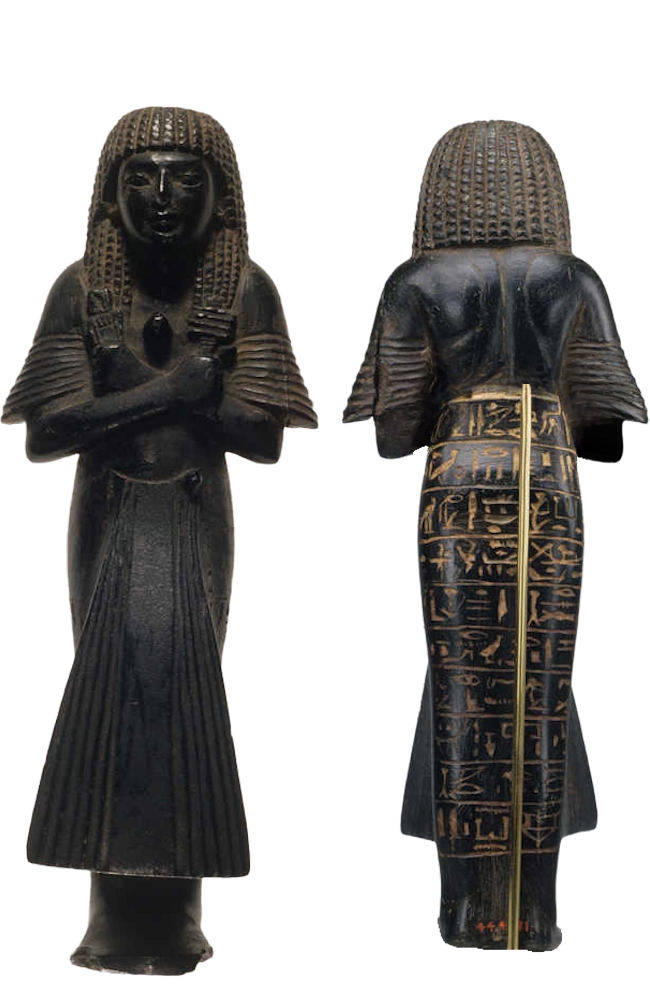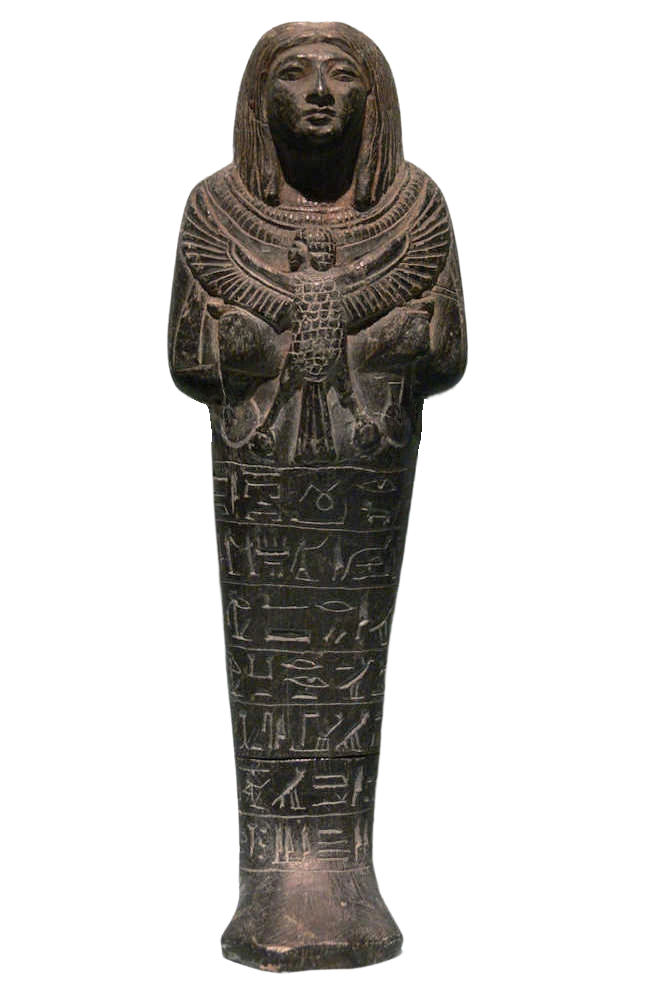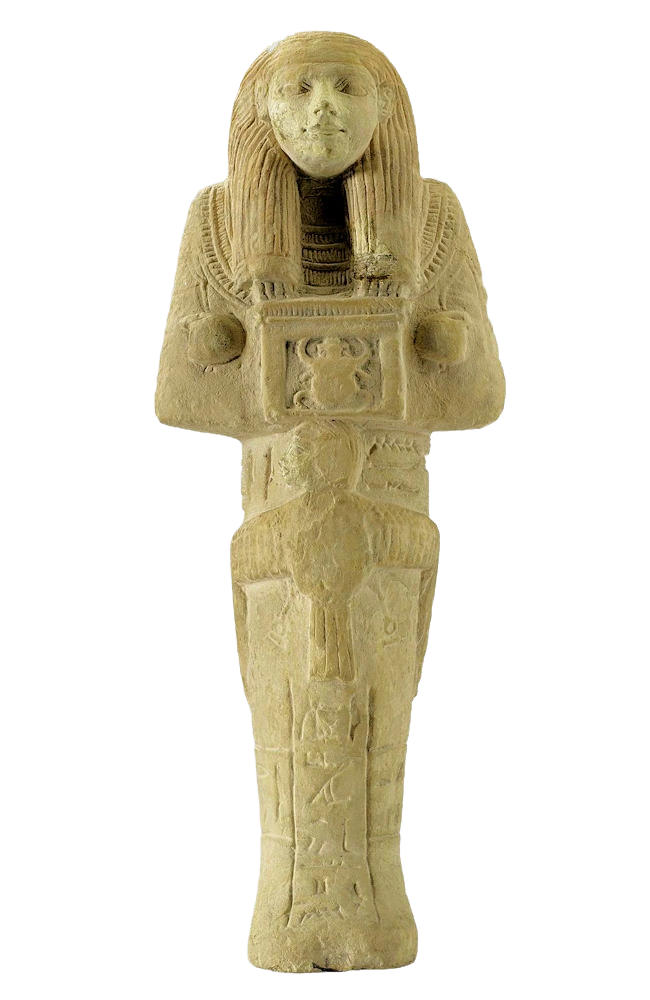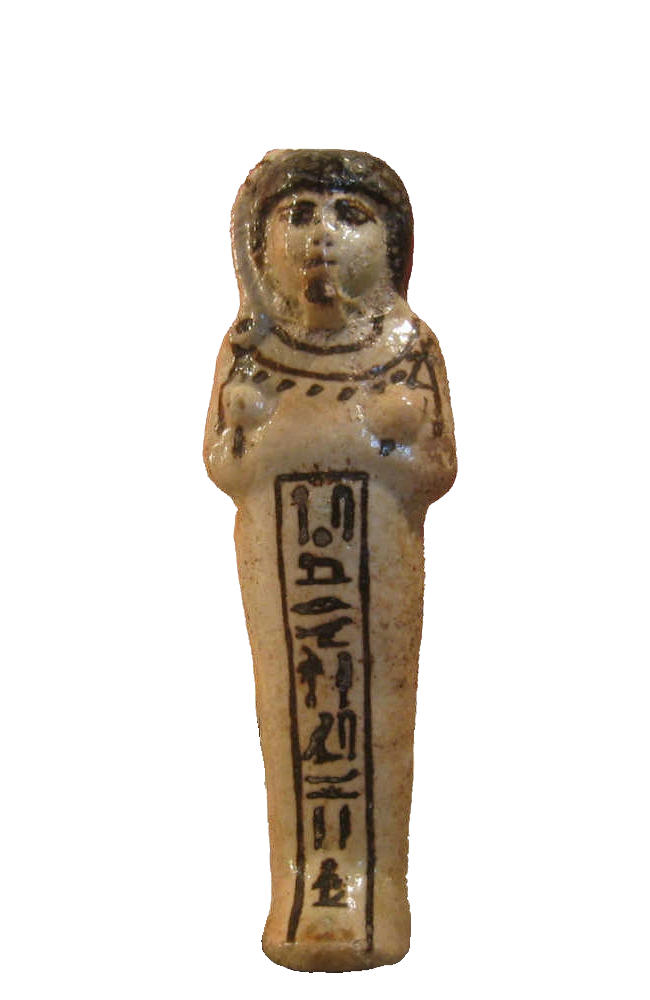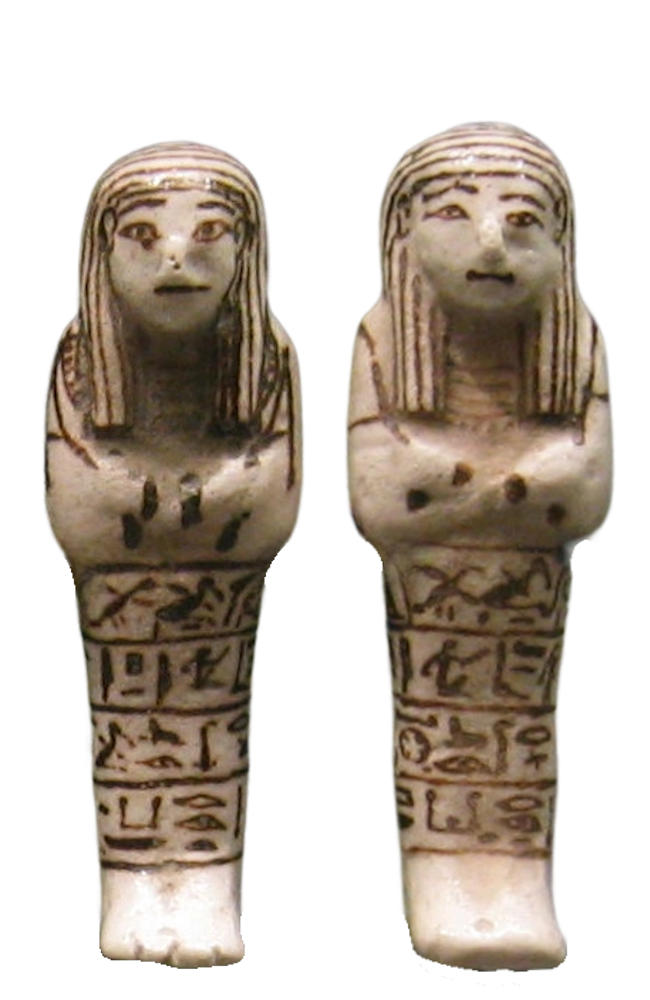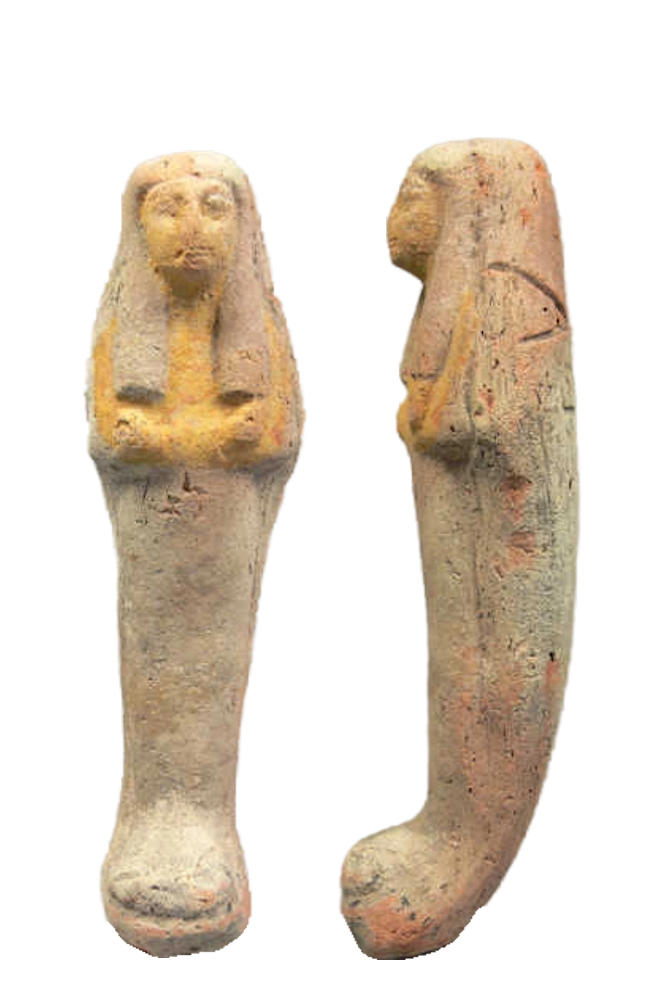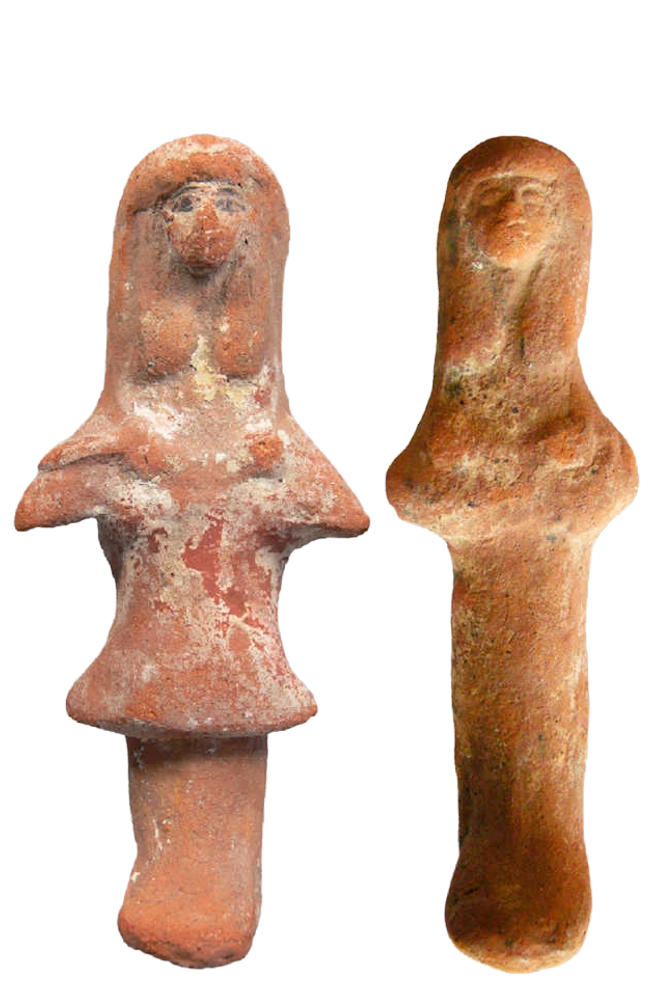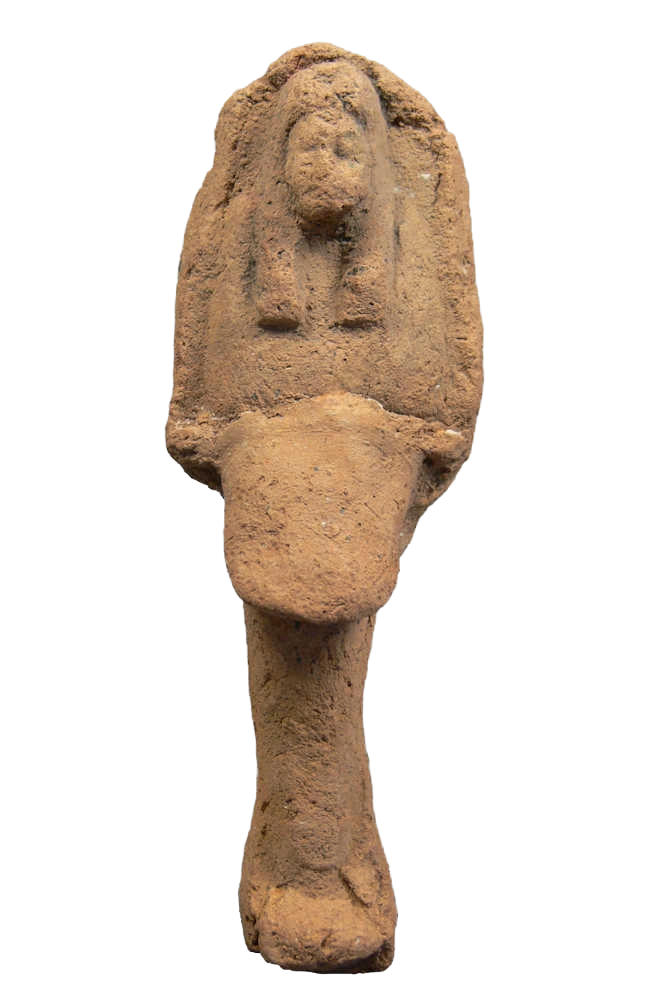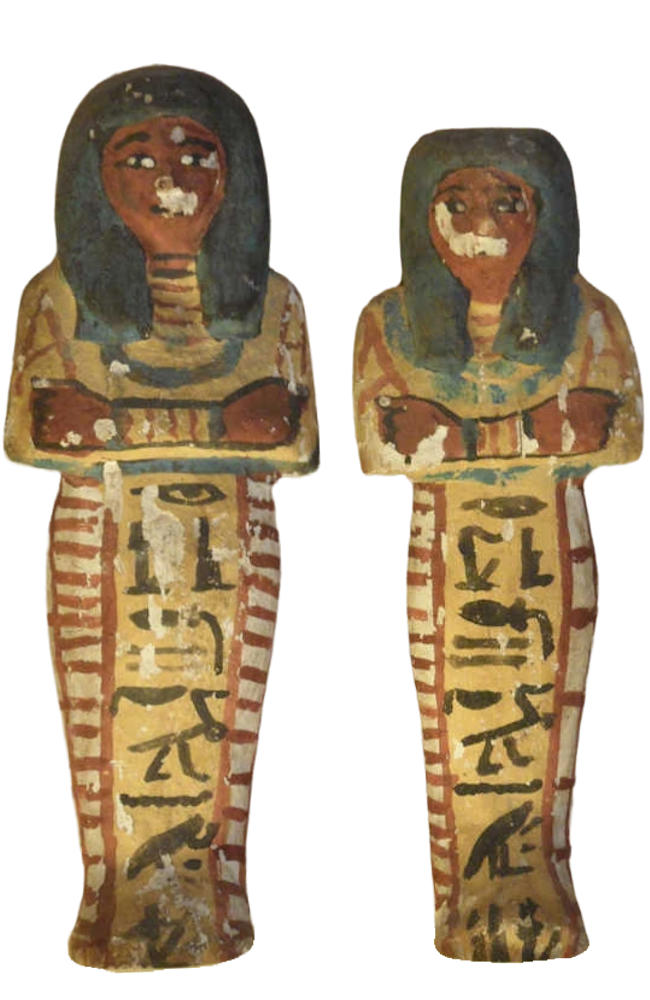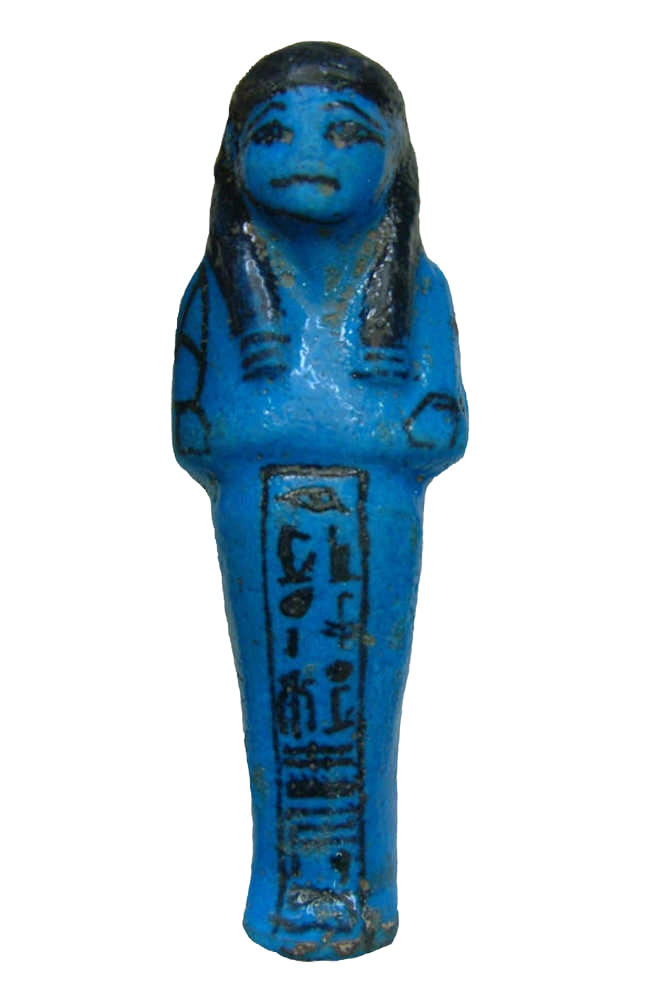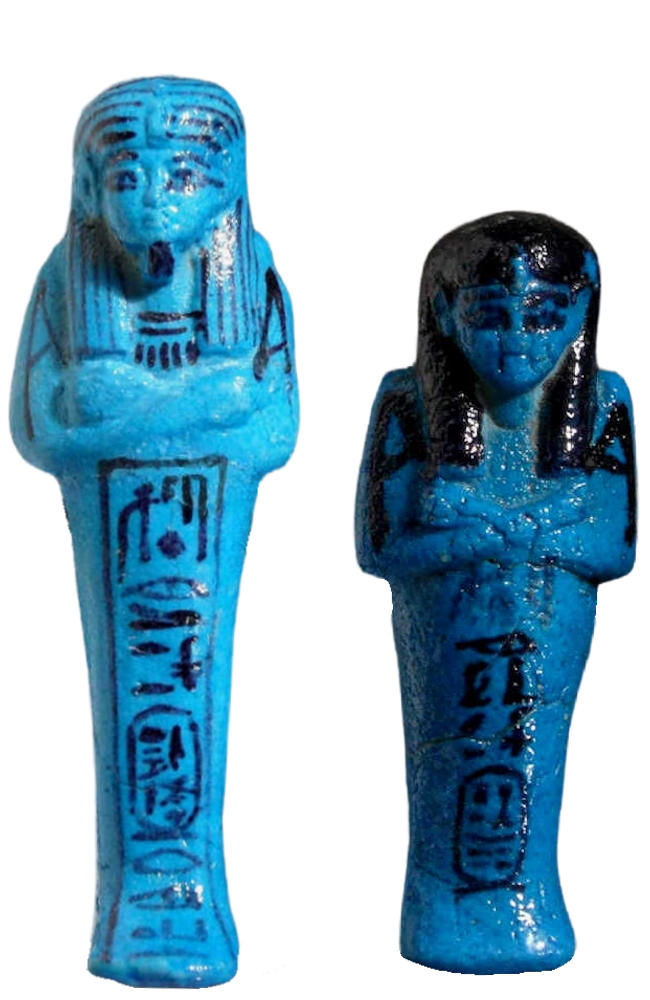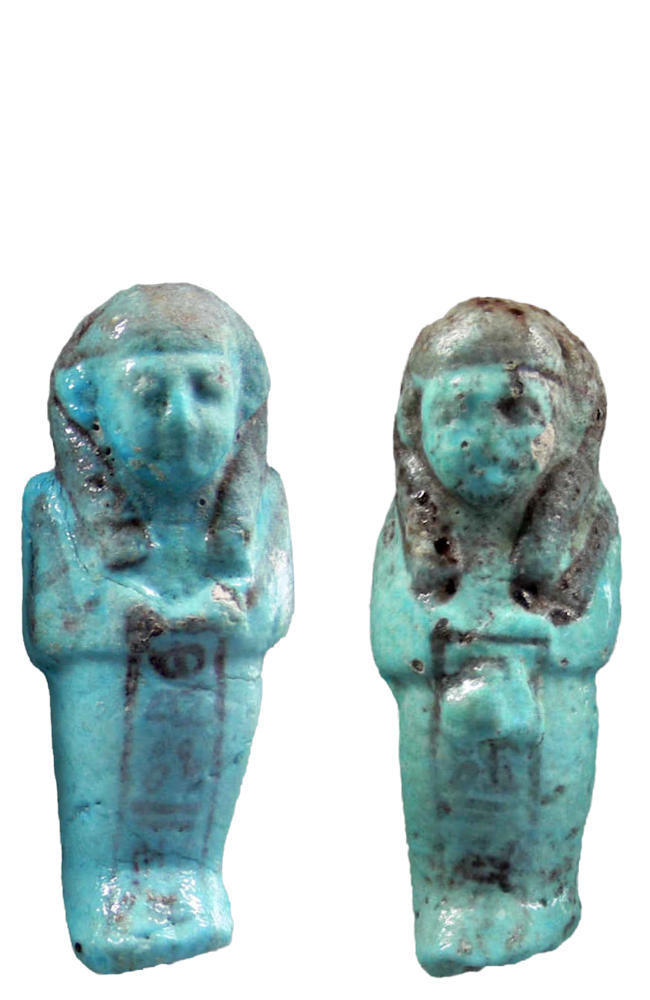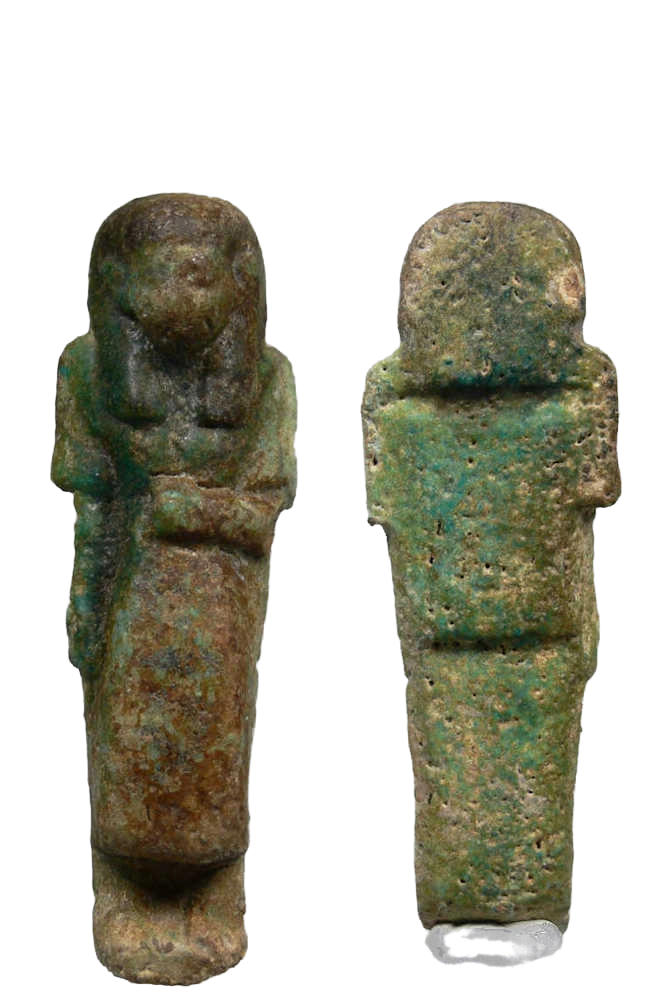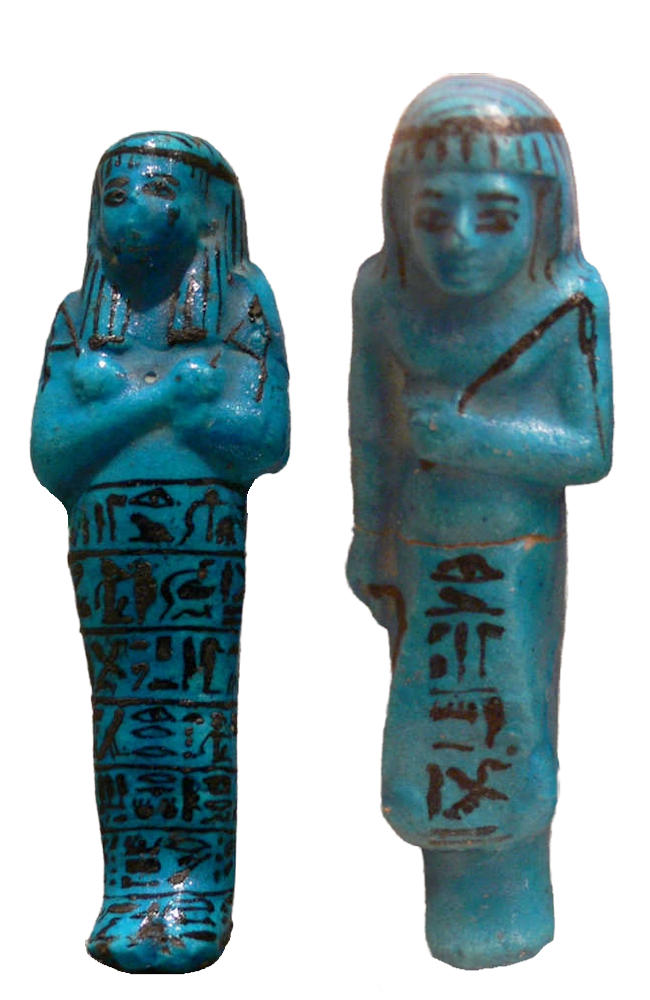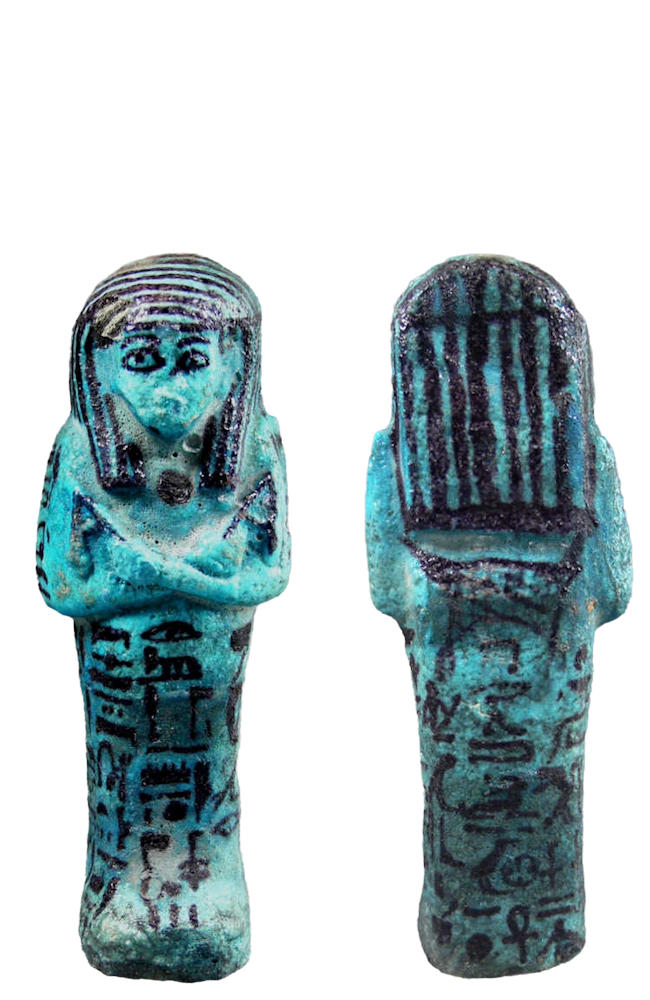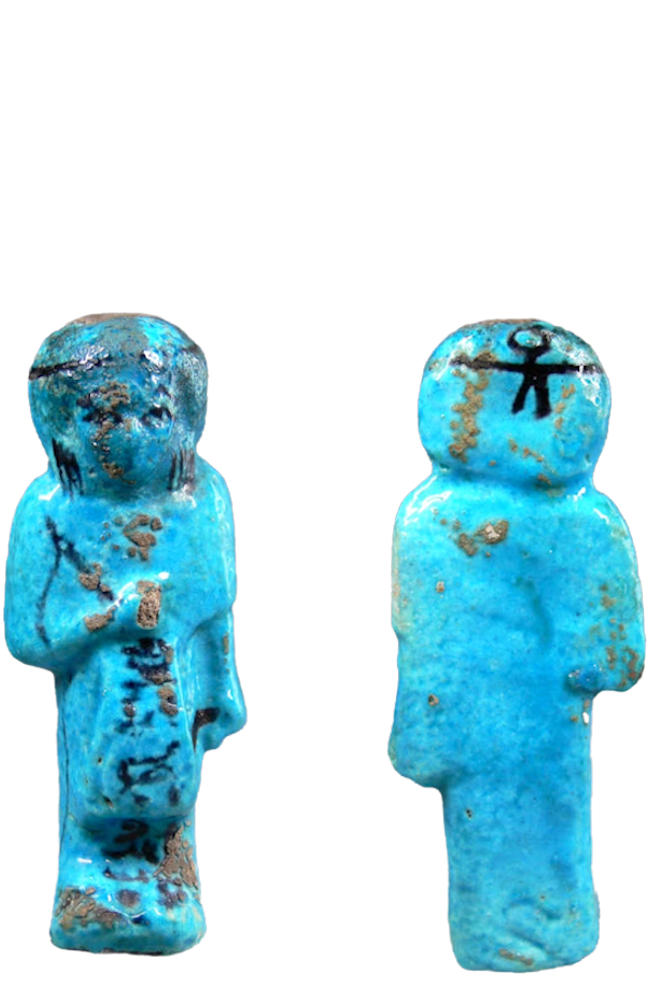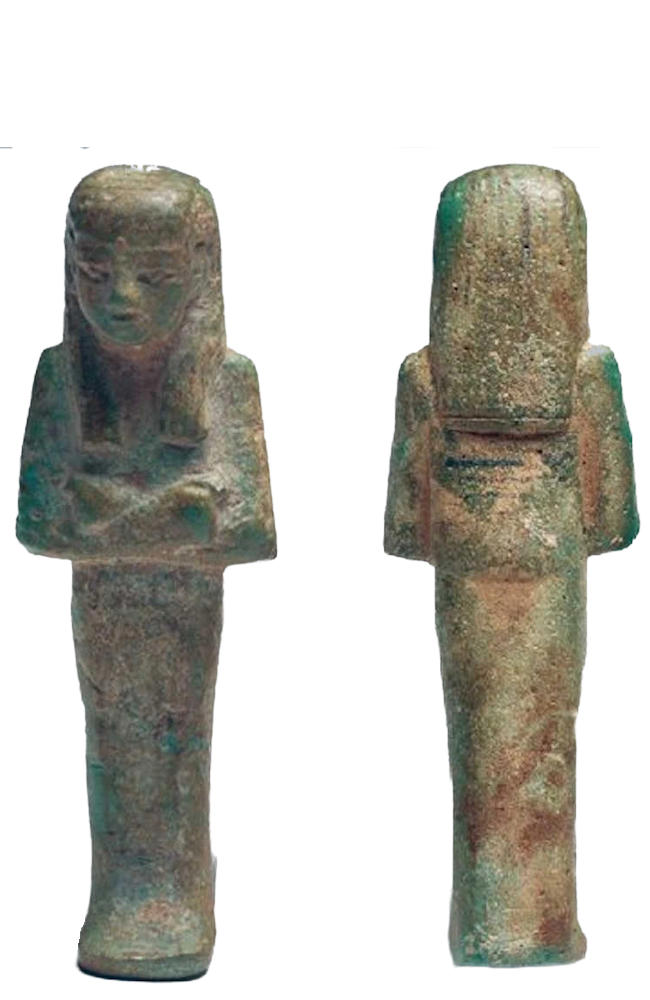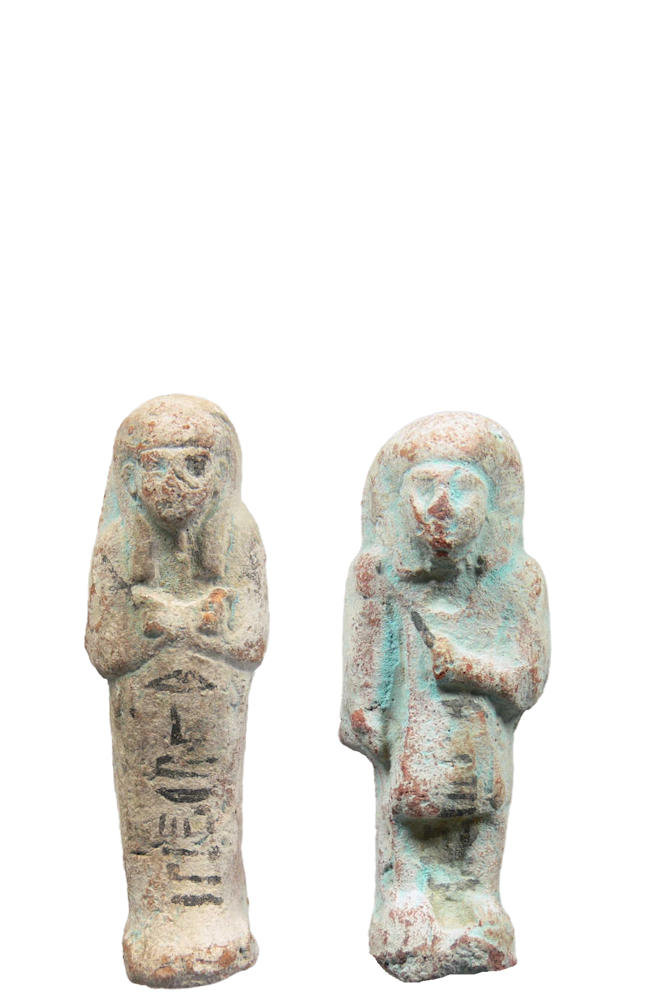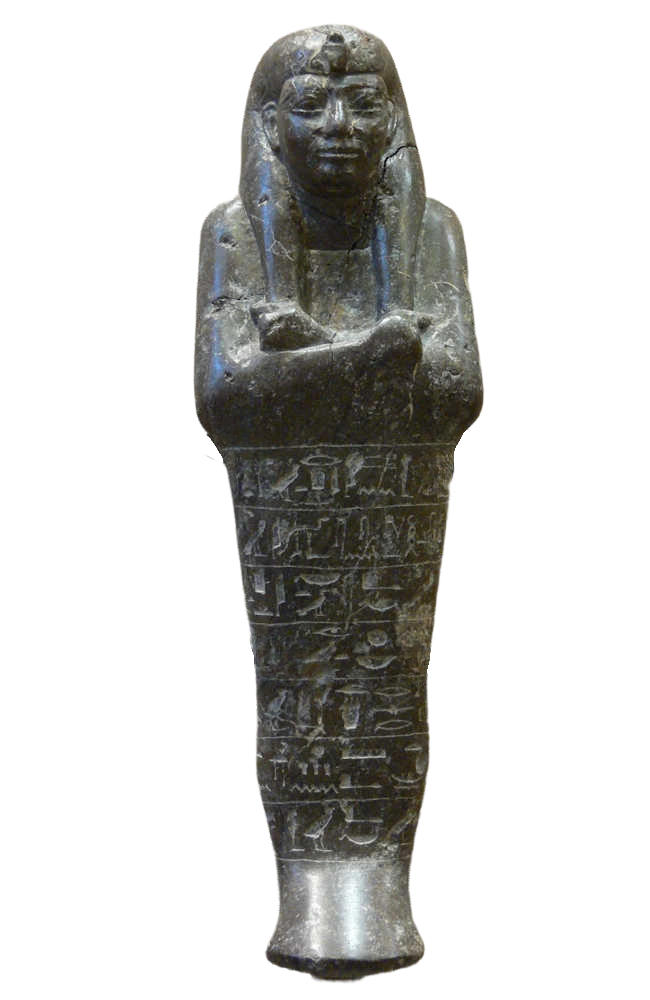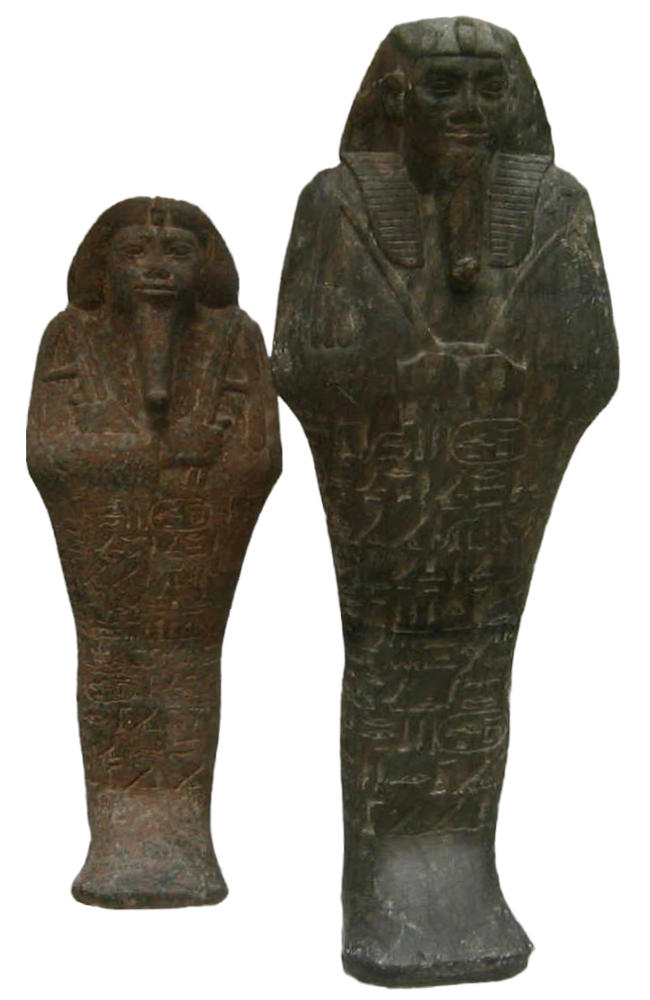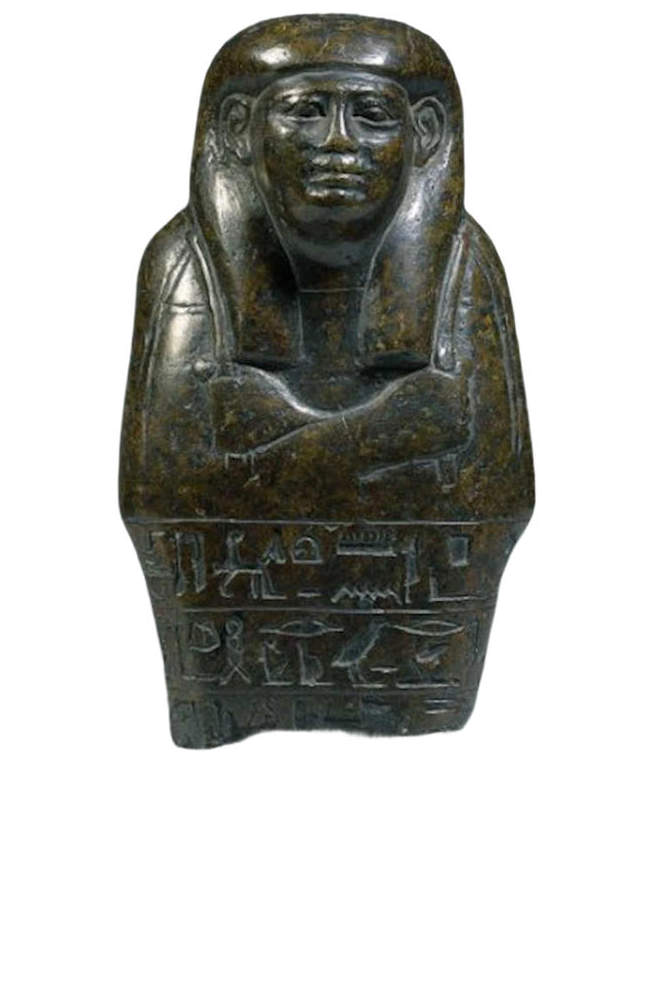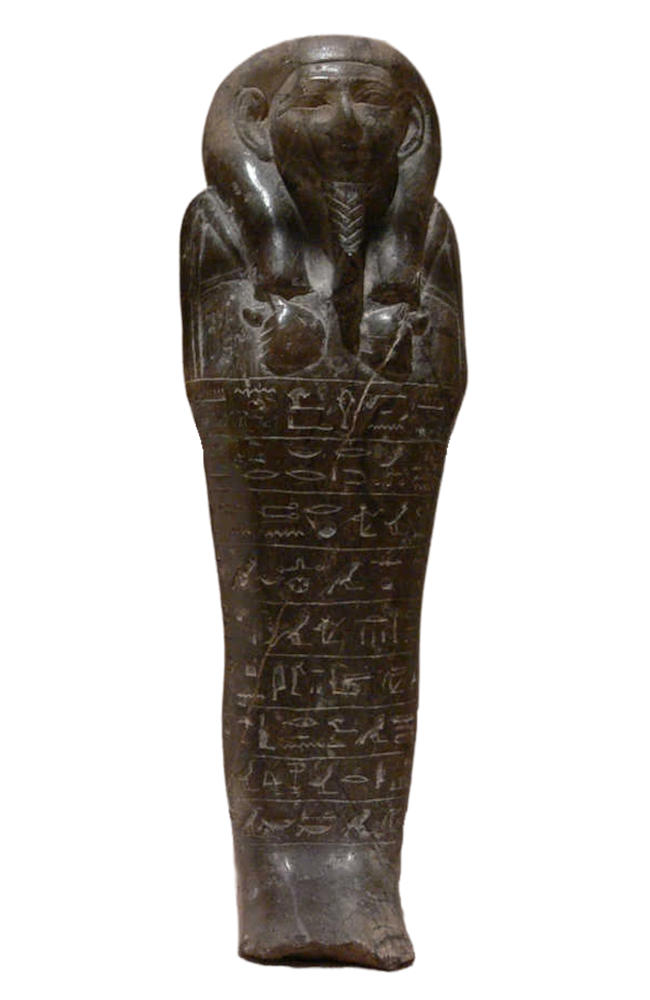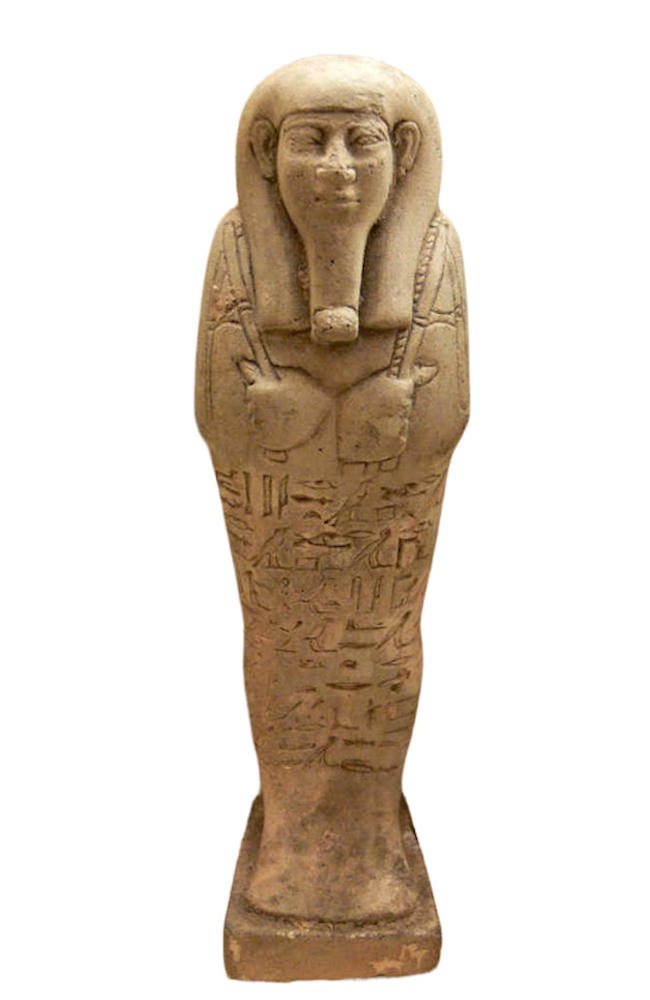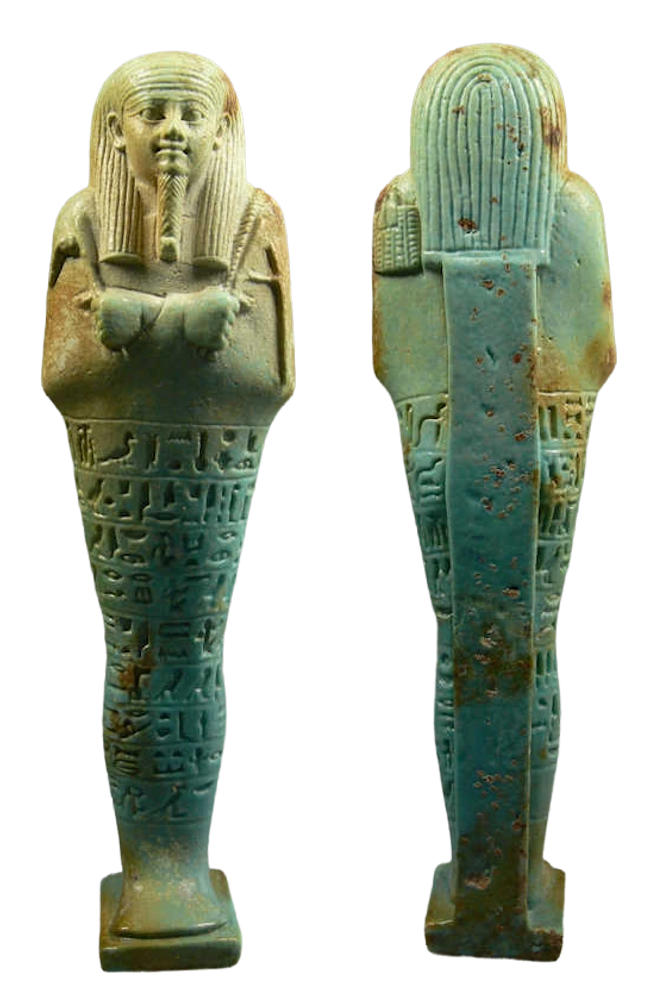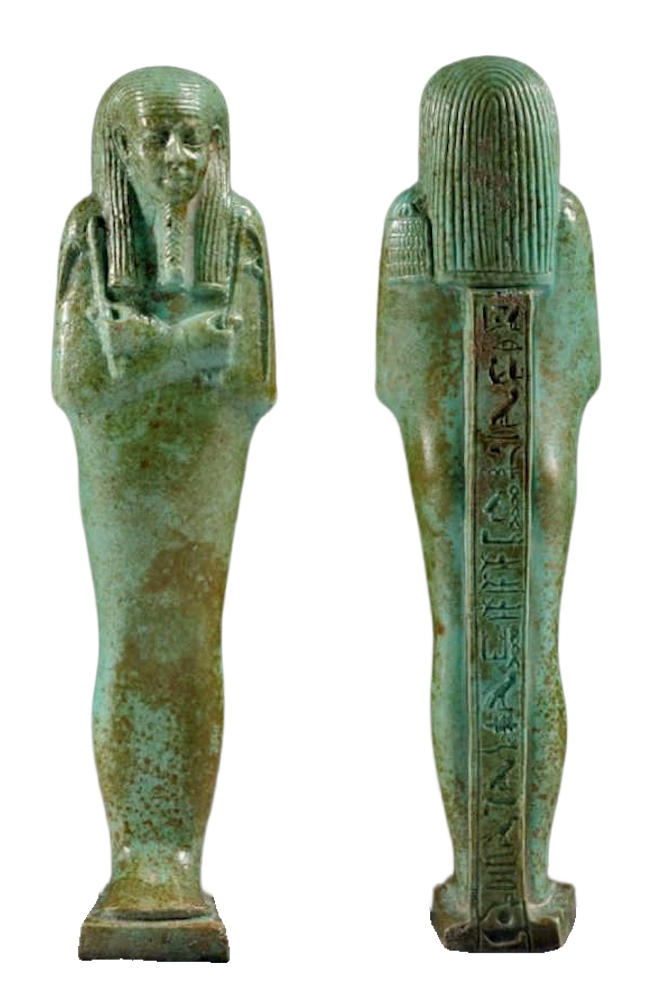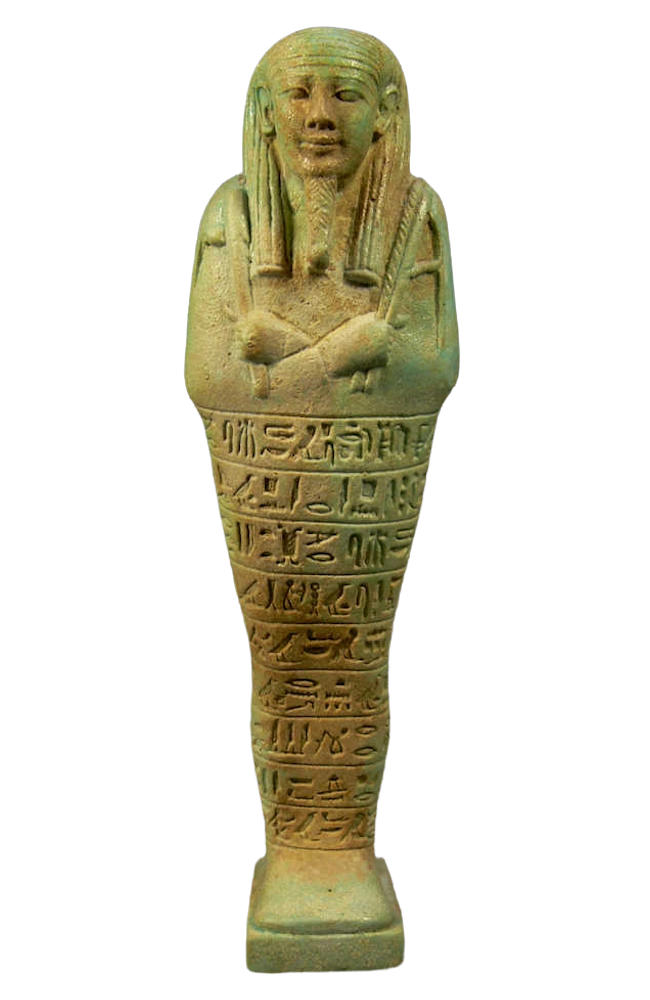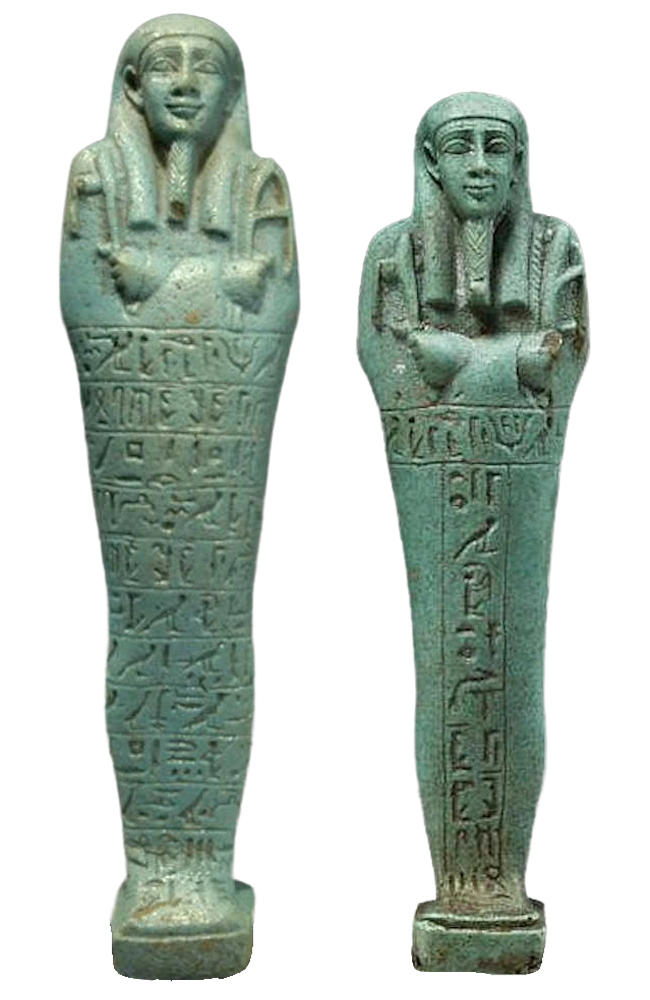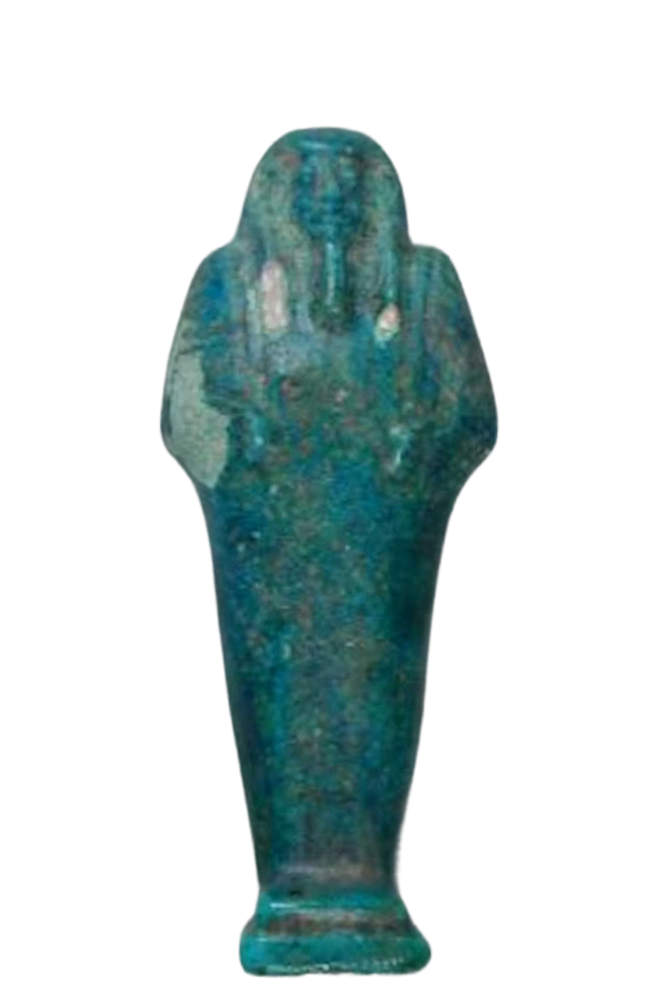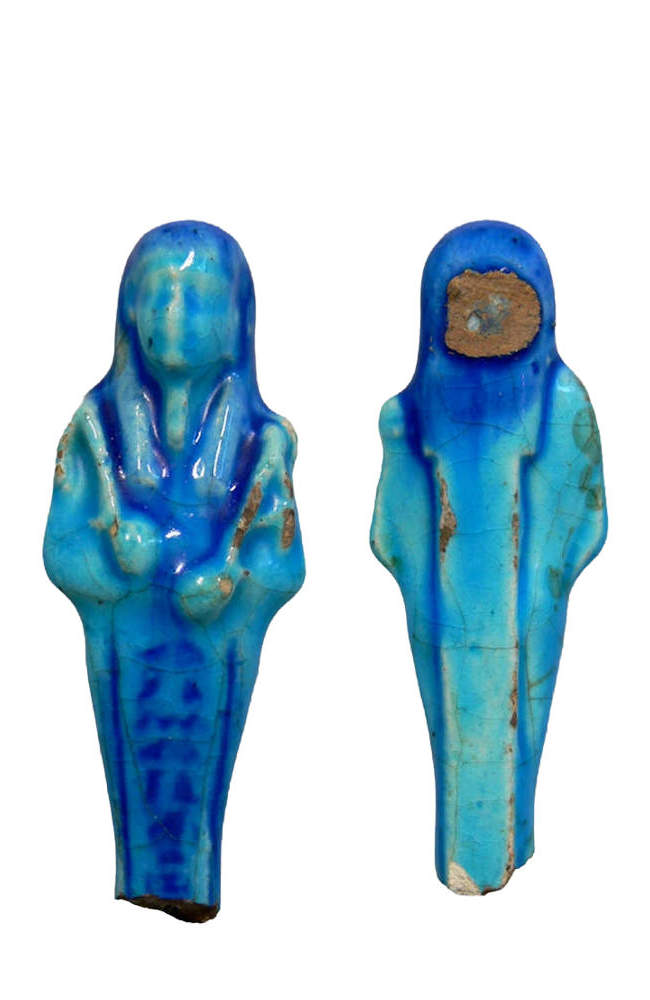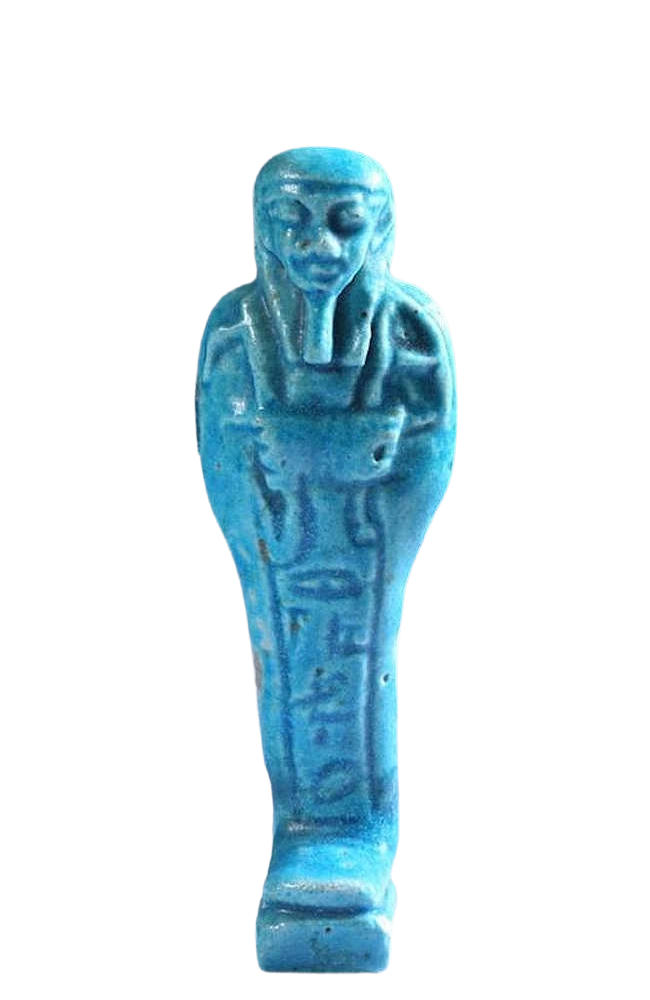Chronological overview of Shabtis development
On this page you can find an overview of the development of shabtis over a 2000-year period. These 2000 years are subdivided into shorter periods and illustrated with examples of shabtis from those periods. The most important developments are discussed, as well as the notable differences.
Although the shabtis are dated as precisely as possible, in most cases a good foundation for correct dating is impossible. Exceptions are statuettes of royals and of dignitaries known to have served under a specific pharaoh. Please allow for variations on the order of decades.
11th Dynasty
2134 – 1991 BC, Middle Kingdom
Rise of Osiris worship with Abydos as centre.
Over four-thousand years ago, a tradition arises where the deceased are given a death figurine to go into their tomb with them. In view of the small number of statuettes from this period that have been found, it remains unknown to me whether it was usual to have the deceased accompanied by one or by more shabtis. It is also unclear whether they only accompanied dignitaries who had been very close to the pharaoh, or if they were also interred with the rich who could afford a good tomb.
The figurines are made from beeswax. This wax was said to have magical powers of protection, regeneration and resurrection. The statuettes depict a straightened body with the arms along its sides. Their form is elementary and they are fully naked with clearly visible sexual characteristics. Wrapped in linen, the figurine is laid in a small wooden box and interred with the deceased. The figurines do not have a worker role as yet, and it is assumed that they are intended to replace the body of the deceased in case it should perish or decay.
Neferu
Queen
Wax, 8.1 cm, coffin 18.4 cm
11th Dynasty, ca. 2000 BC
Museum of Fine Arts, Boston 37.550a-c
Photo: MFA, Boston
Unknown male
Wax
11th Dynasty, ca. 2000 BC
Staatliches Museum Ägyptischer Kunst, Munich ÄS 6085
Photo: Khruner`
Unknown female
Wax, 12.8 cm
11th Dynasty, ca. 2000 BC
Global Egyptian Museum E.7264B
Photo: Global Egyptian Museum
12th Dynasty
1991 – 1782 BC, Middle Kingdom
Once again, shabtis are interred in order to replace the mummy when needed. They are modelled after a mummy and are often carved from stone. The statuettes bear no inscription, or they carry the name of the owner and in some cases the name of the mother. Over the course of the dynasty, the offering formula is added (generally referred to as the ḥtp-dỉ-nsw formula).
By the end of the dynasty, shabtis with an early form of the shabti formula start appearing. These specific shabtis are assigned a worker role. Although more than one shabti was interred in a number of tombs, this remains limited to a few per tomb, with a maximum of five to ten. With the exception of kings’ tombs, the number of shabtis will remain low until the second half of the 19th dynasty.
Redyenptah
Limestone, 20.2 cm
12th Dynasty , ca. 1900 BC
Kunsthistorisches Museum Wien
ÄS 8311 – GE 09/001/5620
Photo: Global Egyptian Museum
Senbi
Wood, 36.2 cm
12th Dynasty, ca. 1900 BC
The Metropolitan Museum of Art, New York 11-150-14
Photo: MMA NY
13th – 16th Dynasties
1782 – 1663 BC, Second Intermediate Period
On a number of shabtis, hands appear on top of the mummy wrappings, usually holding sacred symbols such as Hes-jars, Ankh-symbols, Was-sceptres, and pieces of cloth. Sometimes a Djed is depicted as well. The ears are often large.
Since they are potentially dangerous to the mummy, hieroglyphs of people, animals and reptiles are depicted in a mutilated form. Birds, for example, are shown without feet, and snakes without heads.
Renseneb
Limestone
13th Dynasty, ca. 1750 BC,
ca. 23 cm
Musées Royaux du Cinquantenaire à Bruxelles
Photo: VB
Nen
Serpentine, 21.7 cm
13th Dynasty, ca. 1750 BC
Musées Royaux du Cinquantenaire à Bruxelles, E.3384
GE 07/003/515
Photo: Global Egyptian Museum
Wahneferhotep
Prince
Wood with gold leaf, 21 cm Memphite Region
13th Dynasty, ca. 1750 BC
The Metropolitan Museum of Art, New York 14.3.70
Photo: MMA
Wahneferhotep
Prince
Shabti coffin
Wood, gold leaf, 25 cm
13th Dynasty, ca. 1750 BC
The Metropolitan Museum of Art, New York 14.3.69a, b
Photo: MMA
17th Dynasty
1663 – 1570 BC, Second Intermediate Period
Struggle of the Thebans against the Hyksos who had conquered northern Egypt.
Interring wooden shabtis with a roughly human form vaguely similar to a twig or branch came into use in the Theban region during the 17th and early 18th dynasties. This form was not a consequence of a bad or weak period, but it was intended to symbolise growth and thriving, similar to a tree with numerous twigs. There is also a plausible theory that a stick shabti could represent two persons, the deceased himself as well as someone who had died earlier and will serve him.
Ipu
Wood, 14.7 cm
17th Dynasty, ca. 1600 BC
Pelizaeus Museum, Hildesheim 6014
GE 04/30/11516
Photo: Global Egyptian Museum
Tetyankh and Tetiky
Wood, estimated 15 cm
17th Dynasty, 1600 BC
Musée du Louvre, Paris E32373
Photo: Louvre
Senakhtpu
Son of Khonsu and
brother of Imennefer
Wood, 15.6 cm
17th, early 18th Dynasty,
ca. 1575-1550 BC
Probably from Dra-Abu-el-Naga
German private collection
All around movie
Courtesy AB 2022
From left to right
Mai
Bau…
Name illegible
Tetinefer
Wood
17th Dynasty, ca. 1600 BC
Ashmolean Museum, Oxford
1930.416 (6)
1888.552 (7)
1942.106 (8)
1889.933 (9)
Photo: VB
18th Dynasty
1570 – 1418 BC, Early 18th dynasty, New Kingdom
Ahmose I, the first pharaoh of the 18th dynasty, expels the Hyksos kings from Egypt. Thebes once again becomes the central capital of Egypt. In the Valley of the Kings and Queens, to the west of the Nile, kings (pharaohs), queens and princes are buried in magnificently decorated tombs.
Shabtis
The New Kingdom marks a period of high-quality shabtis. Especially during the 18th and 19th dynasties, the quality of form and details can sometimes be superior. Necklaces (usekh/wesekh) appear for the first time, and we see shabtis in daily clothes and magnificent wigs, affectionately embracing beautifully stylised Ba-birds. The faces, clothes and sandals of many stone shabtis are extremely beautiful and intriguing.
Over the course of the New Kingdom, the role of the shabtis as workers for the deceased becomes more important and by the end of this period large numbers of shabtis, including overseers, are interred together.
Ahmose I, the first pharaoh of the New Kingdom, is probably the first pharaoh to take shabtis with him into the tomb. Even for him it no longer seems self-evident that he does not have to work in the Hereafter, so he takes shabtis with him to be on the safe side.
Since the workmanship of shabtis undergoes an enormous development in the New Kingdom, six separate sections are included below regarding the period ending with the 20th dynasty
Shabti coffins
With the shabti of Amenhotep (last one in this section) we also see a matching coffin. These coffins are known from the Middle Kingdom onward, often bear resemblance to the owner’s coffin, and begin to fall out of use once the shabtis are provided with implements around 1400 BC. As time passes, the shabtis with implements are made in greater numbers and placed in shabti coffins
Ahmose I
Pharaoh (earliest pharaoh shabti)
Stone, 28 cm
Early 18th Dynasty, 1546 BC
British Museum, London
EA 32191
Photo: British Museum
Sjemity
Wood, 26 cm
Early 18th Dynasty, ca. 1570 BC
Kunsthistorisches Museum, Wien ÄS 898
GE 09/001/5792
Photo: Global Egyptian Museum
Amenhotep II
Pharaoh
Limestone, 20.5 cm
Mid 18th Dynasty, ca. 1420 BC
Brooklyn Museum,
New York 66.99.158
Photo: VB
Pehsoukherou, Pehi
“Porteur d’arc” of Amenhotep II
Stone
Mid 18th Dynasty, ca. 1420 BC
Photo: Statuettes égyptiennes: chaouabtis, ouchebtis, 1974
plate 9-10
Ptahmose
Vizier, Governor of Thebes, First prophet of Amen in Thebes
Faience, 20 cm
18th Dynasty, ca. 1360 BC
Cairo CG 48406
Abydos?, Mariette, 1881
Photo: Offizieller katalog Die Hauptwerke im Ägyptischen Museum Kairo, 1986, no. 150
Amenhotep with coffin
Royal scribe, nickname Hui
Wooden coffin 18 cm
Shabti faience 13.8 cm
18th Dynasty, ca. 1360 BC
Cairo JE 88902
Photo: Offizieller katalog Die Hauptwerke im Ägyptischen Museum Kairo, 1986, no. 151
1418 – 1350 BC, Mid 18th dynasty, New Kingdom
Shabtis with tools
During the reign of Thutmose IV (1419 – 1386 BC), many shabtis are given tools such as hoes with wide or narrow blades, and baskets or bags. At first as individual pieces that are mounted separately or presented as side gifts, and later directly modelled or painted on the statuettes. Until Akhenaton (1350 BC) the baskets and bags are carried at the front of the shabtis (see the first two shabtis)
Repet
White faience, 19 cm
Mid 18th Dynasty, ca. 1400 BC
Musée des monnaies, médailles et antiques 854
Photo: André Pelle, Statuettes funéraires égyptiennes du département des Monnaies, Médailles et Antiques
Amarna period
1350 – 1334 BC, Late 18th dynasty, New Kingdom
Rule of Akhenaton and his queen, Nefertiti, with Aton as the main god. They abandon the traditional worships of Amun and Osiris, and introduce a new one centring on Aten.
Shabtis
This may be the only period where shabtis may have ear decorations (see Hat). It is also around or during this period that women’s wigs first appear (see Isis). Akhenaton’s shabtis do not carry tools, but they do wear Ankh-amulets or pharaonic regalia such as the crook and the flail. The only inscriptions on the Akhenaton shabtis are the kings’ names and titles.
Hat
Adjutant reign of Akhenaton
Limestone, 20 cm
18th Dynasty, ca. 1340 BC
Stolen from Egyptian Museum 28/01/2011, Cairo JE 39590
After recovery the paint on the mouth, eyes and eyebrows was lost. See here.
Photo: Catalogue Cairo Museum 2003 (before the robbery)
Isis
Songstress of the Aton
Limestone, 22.3 cm
18th Dynasty, ca. 1340 BC
The Metropolitan Museum of Art, New York 66.99.38
Photo: VB
Post-Amarna
1334 – 1293 BC, Late 18th dynasty, New Kingdom
Tutankhamun ended the worship of Aton and rehabilitated the cult of Amun.
This period spells the end of mummiform shabtis without tools. Hoes are increasingly carried on the chest and upper arm while other tools, such as carrying poles, baskets and bags, are no longer carried in front of the body but over the shoulder or on the back (see Meryre, the first one). Also appearing around this time are the magnificent shabtis in the dress of daily life and holding amulets and/or Ba-birds (see Meryre, the second one).
Meryre
Limestone, 26 cm
18th Dynasty, ca. 1320 BC
Sothebys, New York, 8 Dec 2010,
lot 76
(seed bag slung over the shoulder)
Photo: Sothebys
19th Dynasty
1293 – 1185 BC, New Kingdom
A new golden age for Egypt with great pharaohs such as Seti I and Ramses II.
In addition to the breathtakingly beautiful stone shabtis holding amulets and/or a Ba-bird, wooden and faience shabtis appear that wear the dress of daily life and hold their hands on their skirts (see Amunemwia and Panehesy). These shabtis are probably still intended as replacement for the mummy.
By now the production of faience and terracotta has become commonplace and the number of shabtis is increasing to several tens per tomb. By the end of the dynasty the shabti with both hands on his skirt has been transformed into overseer. An overseer is responsible for a group of workers and is equipped with one or two whips resting across the upper arms.
How this transformation into overseer took place is not clear. It seems that the Egyptians were experimenting with different forms. Neshor, for example, is a worker with winged shoulders that seem to carry two whips, and the last pictures show, from left to right, a wooden overseer with probably two whips, a winged overseer with a whip resting on his arm, and finally a simple terracotta worker upgraded by affixing a skirt. During the 21st Dynasty the overseer becomes more recognisable because one of the arms is extended along the side.
At the end of the dynasty the priestly side lock comes into use (see Huy), and it will be depicted on priests until the start of the 20th dynasty. The roughly formed terracotta shabtis with curved feet are becoming popular too.
Amumemwia
Goldsmith
Faience, worker 11.1 cm, dress of the living 13.5 cm
19th Dynasty, 1280 BC
Dutch private collections
Photo: VB
Panehesy
Treasurer reign of Ramses II
Faience, ca. 12 cm
19th Dynasty, 1280 BC
Louvre, Paris N869
Photo: VB
Amenemope
Administrator of the Harem
Serpentine, 18.2 cm
Early 19th Dynasty, 1270 BC
Rijksmuseum van Oudheden (RMO), Leiden AF 26,
Schneider 3.2.1.6
Photo: VB
Taenuhuya
also known as Thauenhuya
Limestone
Early 19th Dynasty, 1280 BC
Possibly from Sheikh Abd el-Qurna, Thebes
Royal Scottisch Museum, A.395.6
Photo: Reddit.com
Seti I
Pharaoh
Faience, 15.1 cm
Early 19th Dynasty, 1278 BC
The Cleveland Museum of Art, 1914-585
Photo: The Cleveland Museum
Huy
High priest of Ptah
Reign of Ramses II
Faience, ca. 14 cm
19th Dynasty, ca. 1240 BC
Louvre, Paris
Photo: VB
Without name
Yellow face, probably female
Terracotta, 15.2 cm
Late 19th Dynasty, ca. 1190 BC
Dutch private collection
Photo: VB
Neshor
Overseer and worker
Terracotta
Late 19th Dynasty, ca. 1190 BC
Ashmolean Museum, Oxford 1926.211
Photo: VB
Without name
Overseer
Terracotta, 17.3 cm
Late 19th Dynasty, ca. 1190 BC
Dutch private collection
Photo: VB
Ramessu
Worker
Limestone, 23 cm
Son of Sennedjem
Ramses II period, ca. 1250 BC
German private collection
Photo: AB
All around movie
German private collection
Courtesy AB 2022
20th Dynasty
1185 – 1070 BC, New Kingdom
The Ramesside Period is a time of unrest, with fights against the Libians, Libyans and Sea people. Egypt weakens after the death of Ramses III due to corruption, civil unrest and famine.
Shabtis from this period often have their forearms horizontal, and the forearms generally have painted edges. Long, horizontally extended thumbs are often visible.
The entirely new (possibly foetal) peg-shabti form also known as “contour perdu” (meaning ‘lost contour’) makes its first appearance and is interred with both private persons and royals (see Ramses VI). This type is only in vogue for a couple of decades.
Bakenmut
Wab priest
Terracotta?
Late 20th Dynasty, ca. 1185 BC
Archeological Civic Museum (MCA) of Bologna KS 2132, KS-2133
Photo: VB
Ramsesmentukhepersef
Prince, son of Ramses IX
Faience, ca. 16 cm
Late 20th Dynasty, ca. 1090 BC
Kings Valley, tomb KV 19
Cairo Museum
Photo: Tim Haines
All around movie of another worker
German private collection
Courtesy AB 2022
21st – 24th Dynasties
1070 – 715 BC, Third Intermediate Period
Pharaonic rule became so weak during the reign of Ramses XI that governor Smendes in Tanis in Lower Egypt could found the 21st dynasty, probably even before the death of Ramses XI.
In Thebes in Upper Egypt the High priests of Amon took power, and after a few decades former High Priest Pinedjem I proclaimed himself pharaoh over Upper Egypt.
The 22nd-24th Dynasties (945 – 715 BC) are the Libian Period. The Libian berber Sheshonq I becomes king of Lower Egypt and founder of the twenty-second dynasty. Under Libian rule the country lapses into small fiefdoms and local rulers.
(U)shabtis
This is one of the most fascinating periods for shabti enthusiasts. Thanks to the discovery of the Royal Cache DB320 in 1881 and the Bab el Gasus priest cachette, Cache II in 1891 (both near Luxor) many shabtis were spread throughout the world. Since so many mummies, boxes, funerary items and shabtis were recovered in a short time, thousands of shabtis were given and/or sold to museums, dealers, tourists and collectors. Even the souvenir shop of the Egyptian Museum in Cairo sold original shabtis.
Although the workmanship of the shabtis does not come anywhere near that of the New Kingdom, the faience shabtis of this dynasty catch the eye thanks to their beautiful colour. From the deep cobalt-blue also known as “Royal blue” to a magnificent light blue.
A common attribute is the seshed/fillet headband (see Tentipet and Nesimenemhetep). We also see clearly recognisable overseers with a whip in one hand and the other arm along the side, supervising 10 workers each (see Djedptahiufankh).
Ancient Egypt used 10-day weeks, and a year consisted of 360 days plus 5 holidays. Each deceased person was accompanied by some 400 shabtis (365 workers, one for every day, 36 overseers, 1 for every week), male and/or female, regardless of the gender of the deceased. The women can be recognised by the breasts depicted just below the wig (see Isetemkheb, wife of Pinedjem I). The nipples are sometimes visible.
With a few exceptions shabtis are no longer made from wood or stone, and faience and terracotta are now popular. Shabtis from the north of Egypt differ from those found in Thebes in terms of faience and style (see Hornakht). They also miss the special blue colour that is so characteristic of the shabtis from the Theban region. In the north (Tanis) bronze shabtis have been found as well (see Psusennes I), and around 850 BC the short wig becomes in vogue here. Also special are the overseer shabtis depicted in striding pose (whip on forearm, left foot forward).
On the shabti of Pinedjem II (970 BC) the term “Ushebti” is used for the first time, and from this moment on shabtis are called Ushabtis. Prof. Hans Schneider made me aware that ‘ushabti’ is a contamination of ‘ushebti’ and ‘shabti’ and its use is best avoided. But since the term ‘ushabtis’ has been common in recent decades and I couldn’t get a dot.com site with the usual names, I decided to choose ushabtis.com. In the texts I use the term shabti(s) and ushebti(s).
By the end of this period the ushebtis are getting smaller and quality is also suffering. In many graves from the 22nd dynasty and later, only small, roughly-formed figurines made of mud, dried clay or terracotta are interred.
Pinedjem I (left)
High Priest of Amun, pharaoh of Southern Egypt
Faience, royal blue, 13.6 cm
Royal Cache DB320
21st Dynasty, 1026 BC
Dutch private collection
Henuttawy (right)
Queen, wife of Pinedjem I
Faience, royal blue, 11.7 cm
Royal Cache DB320
21st Dynasty, 1040 BC
Dutch private collection
Photos: VB
Isetemkheb
Worker and Overseer (modified worker) with small skirt and worker
Faience, both 9.6 cm
Bab el Gasus, Cache II Thebes
21st Dynasty, ca. 1000 BC
Theban region
Dutch private collections
Photo: VB
Pasebakhaniout
Prince, Overseer
Son of pharaoh Menkheppera
Faience, 11 cm
21st Dynasty, ca. 1000 BC
Dutch private collection HV
Photo: VB
Psusennes I
Pharaoh, Tanis, North-Egypt
Worker and Overseer
Bronze, both 7.2 cm
21st Dynasty, ca. 991 BC
Tanis region
Emmacha collection, 25-26
Photo: La Collection Emmacha
Antiquités Egyptiennes. Tome 1 : Les shabtys et ouchebtys. Pg 75
Pinedjem II
High Priest of Amun
Worker and Overseer
Faience, royal blue, 17 cm
Royal Cache DB320
21st Dynasty, 970 BC
Dutch private collections
Photo: VB
Imenemipet
Master of Secrets
Faience, 10.9 cm
21st Dynasty, ca. 970 BC
Theban region
Dutch private collection
Photo: VB
Djedptahiufankh
Third Prophet of Amun
Overseer
Faience, 11.2 cm
Royal Cache, DB320
22nd Dynasty, 935 BC
Theban region Dutch private collection
Photo: VB
Hornakht
Prince
Faience, 15 cm
22nd Dynasty, ca. 860 BC
Tanis region
Arte Primitivo auction, Sep 2010, lot 392
Photo: Arte Primitivo
Tjayenheboea
Worker and Overseer
Pottery, painted light blue,
both 7.3 cm
22nd Dynasty, ca. 800 BC
Theban region
Dutch private collection
Photo: VB
25th Dynasty
747 – 656 BC, Third Intermediate Period, Kushite period
Kushite rulers unify Nubia and Egypt with Taharqa as most famous ruler. The capital is Napata.
Ushebtis
Under the Kushite rulers beautiful ushebtis are made of stone. Pharaoh Taharqa took more than a thousand stone shabtis with him in the tomb. The ushebtis have an archaic form which closely resembles statues from the Middle Kingdom, with fuller faces, tight mouths and large ears. Influences from the New Kingdom are also visible on many shabtis.
According to a number of researchers, faience ushebtis from this period are light green or green and the popularity of this colour increases from the 22nd dynasty. Another theory is that they were originally light blue but have suffered from discoloration due to external influences. From light blue to green, from green to brown and sometimes even to black. This may well be a plausible theory. To wit, when you take a close look at green ushebtis, you will often find small blue areas without any discoloration. Also, there are a number of ushebtis where discoloration from blue to green is clearly visible, probably because some parts have been less exposed to outside influences.
Amenirdis I
God’s Wife of Amun
Thebes
25th Dynasty, ca. 670 BC
Oriental Institute, Chicago
OIM 14198
Photo: VB
Padiimenipet
(Petamenope)
Great sorcerer of the King
Serpentine, 15 cm
Thebes
25th Dynasty, ca. 660 BC
Auction, Pierre Bergé & associés, December 1, 2007, Lot 441
Photo: Pierre Bergé & associés
26th Dynasty
664 – 525 BC, Late Period
Saite Period: Psamtek I reunites Egypt and strengthens the ties with the Greeks. Under his rule a period of prosperity dawns for Egypt. Capital is Sais in Lower Egypt.
Ushebtis
In this period, which is also called “Saite renaissance” or “Saite time”, a time of great prosperity leads to the creation of beautiful ushebtis. After the first pharaohs nothing is made of stone any more, and faience is the material of choice. A lot of attention is paid to design and the ushebtis belong to the most beautiful faience ones ever in terms of quality, workmanship and details. Until the 30th dynasty is well on its way, this style changes very little and the Egyptians are able to maintain this level.
Although the typical form of the overseer in the dress of daily life no longer occurs, it is likely that it does not disappear altogether. In many tombs large numbers of blank or partially inscribed ushebtis are found together with larger specimens containing the full text of the usual shabti formula. It is plausible that this last group are assigned the role of overseer.
The ushebtis are equipped with a back pillar, which in some cases carries an inscription (see Horemheb and Hekaemsaf). The hieroglyphs are sometimes pressed into the shabti using a mould, but they are often applied manually, in which case both the outline and the inside of the hieroglyph can be embellished.
The two hoes that are visible on the workers’ upper arms from the 18th dynasty are replaced by one pick and one hoe. The back pillar and the feet of the shabti are placed on a trapezoid block. Until this dynasty the false Osirian god’s beard is only worn by some members of the royal family, including the pharaoh. From now on private persons are also allowed to wear a beard and all ushebtis now come equipped with the beard, sometimes beautifully detailed. The bag which is still worn on the middle of the back during the Third Intermediate period now often hangs from a rope over the left shoulder (see Neferibrasaneith).
Horiraa
Overseer of the Ergastulum
Faience, c. 17.5 cm
26th Dynasty, 600 BC
Reign of Nekho II
Ashmolean Museum, Oxford, Queen’s College loan 63
Photo: VB
Neferibrasaneith
Royal Chancellor
Faience, 18 cm
26th Dynasty, 550 BC,
Reign of Amasis
German private collection
Photo: VB
27th – 31st Dynasties
525 – 332 BC, Late Period
Persian period: Egypt becomes a Persian province. Under the 28th Dynasty, Egypt is freed again and the power of the pharaohs is based on alliance with the Greeks.
Ushebtis
There are several features on the basis of which a normal faience ushebti can be placed in this period; the external differences with those of the 26th dynasty are small.
New is the T-band inscription, see Nesbanebdjed. This type of ushebti consists of fully inscribed specimens and smaller ones with a T-band inscription that could be the workers, in which case the larger ones are overseers.
The writing differs in some details from the 28th dynasty. On some ushebtis the sunbeams (Gardiner N8) used in the text “Sehedj” consist of short, point-like lines instead of continuous lines. Also, the small water symbol (Gardiner N35) is often depicted with only three wave crests. Unfortunately, this is not a general rule, and the old and the new writing style may occur within the same set of ushebtis.
Psamtek
Overseer of the writers of the royal meal
Faience, 19 cm
27th Dynasty, ca. 500 BC, reign of Darius I and Pedusbastis III
Dutch private collection
Photo: VB
Nesbanebdjed
Priest, overseer of Wab-priests in Mendes
Left 19 cm, right 16.9 cm (T-band)
30th Dynasty, ca. 350 BC
Left: Royal Athena Galleries, New York
Right: Sothebys NY Dec. 2008, lot 4
Photo: Royal Athena Galleries, Sothebys
Ptolemaic Kingdom
332 – 30 BC, Greek period
Alexander the Great conquers Egypt; after his death he is succeeded by Ptolemy I Soter who declares himself pharaoh. Alexandria becomes the leading city of the Greek world.
Ushebtis
In this last period, where a lot of ushebtis still accompany the deceased, they are made with beautifully thick glazing (next to the regular faience, clay and terracotta). They already occur during the 30th Dynasty. They are often a two-colour (bichrome) light blue with a dark blue or purplish wig and hieroglyphs (see the third picture for a two-colour ushebti). A number of specimens have round faces and turned-up noses, but ushebtis with beautifully stylised faces and long beards are still being made (see Semset). Over time, the writing gets sloppier and often becomes illegible.
Palaeographical differences can also be seen. The Maat feather (Gardiner H6) is sometimes used with the “true of voice” hieroglyphs instead of the usual plinth hieroglyph (Gardiner Aa 11). In addition, the word “im” is written as a reed leaf (Gardiner M17), and the owl (Gardiner G17) is replaced with the boat symbol (Gardiner P1).
Although the overview ends here with the Ptolemaic period, this is not the end of the custom of giving the deceased ushebtis to accompany them into the grave. However, so far, too little is known about types and sites to be able to say anything meaningful here. According to a study presented in Florence in 2015, ushebtis that might be centuries younger than 30 BC have been found in Roman provinces.
Semset
Left: Faience, 17 cm
Right: Faience, ? cm
Ptolemaic Period, ca. 300 BC
Left: Thalassic Collection
Right: unknown UK antiquities dealer
Photo: Left: The Collector’s Eye, 2001, pg. 132
Without name
Faience, 13.7 cm
Ptolemaic Period, ca. 300 BC
Petrie Museum, London UC40162
Photo: Petrie Museum


